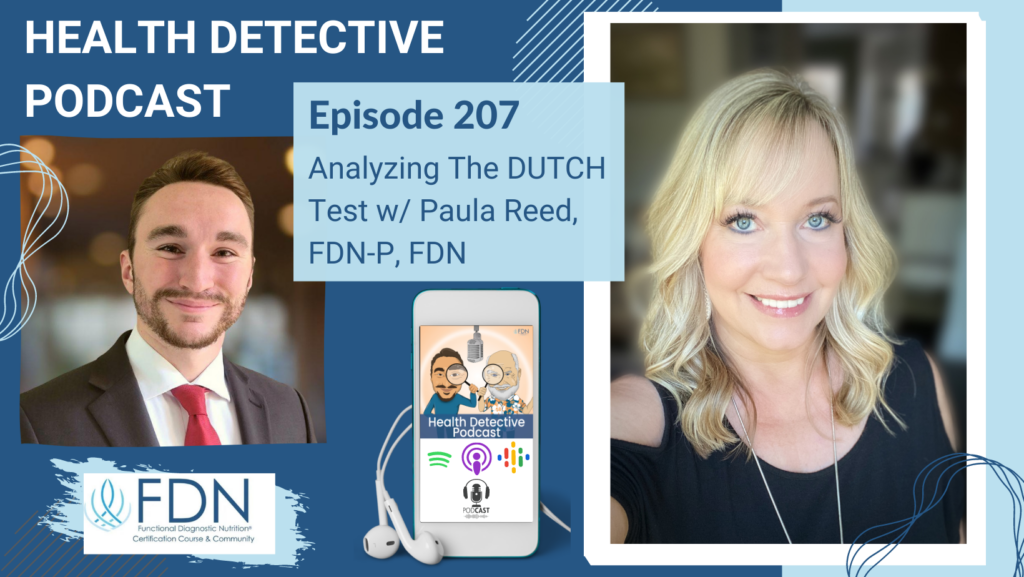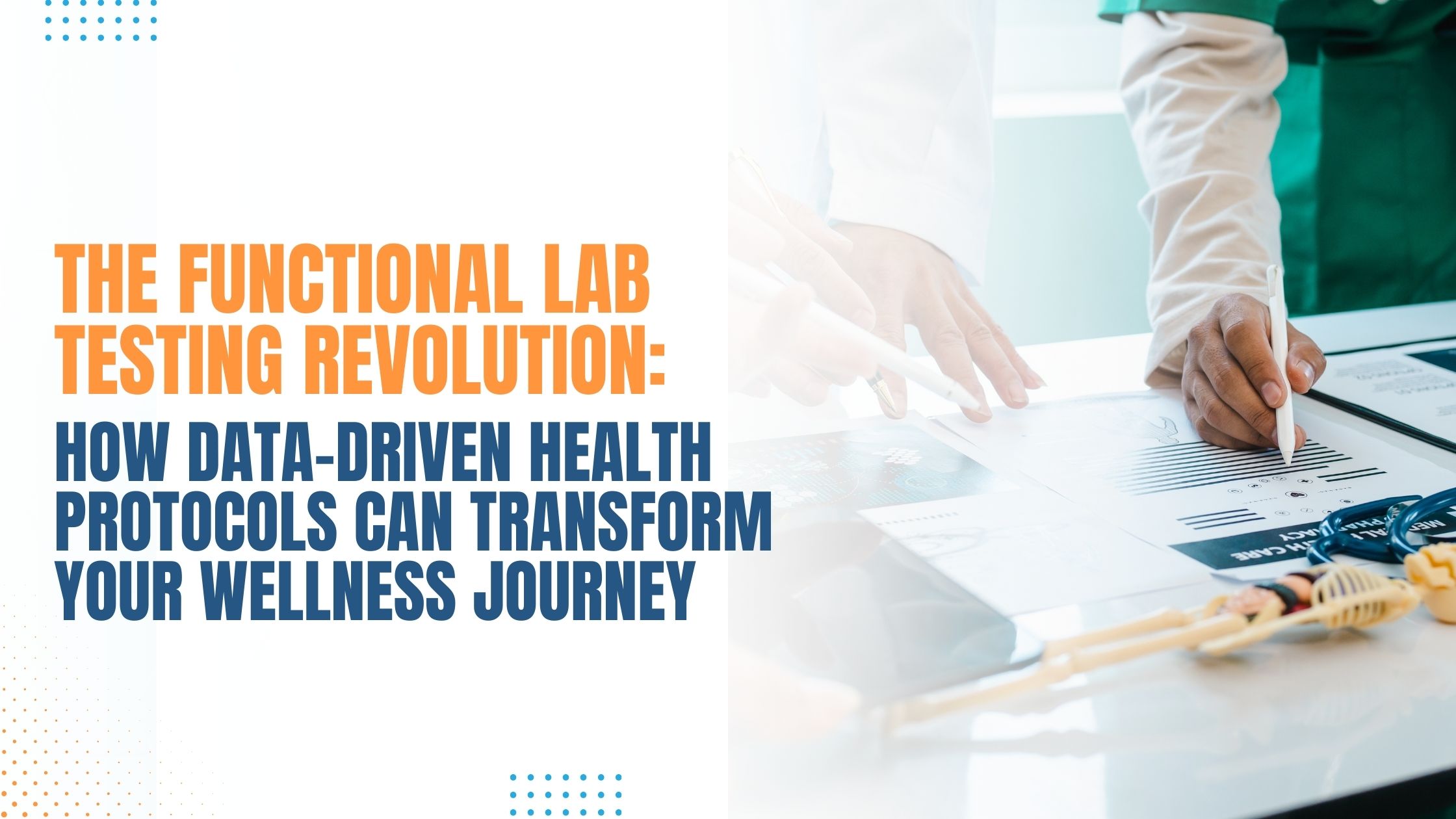Introduction
[00:00:00] Detective Ev: Hello my friends, and welcome back to another episode of the Health Detective Podcast by Functional Diagnostic Nutrition. My name is Evan Transue, aka Detective Ev. I will be your host for today’s show on the analyzing the DUTCH test.
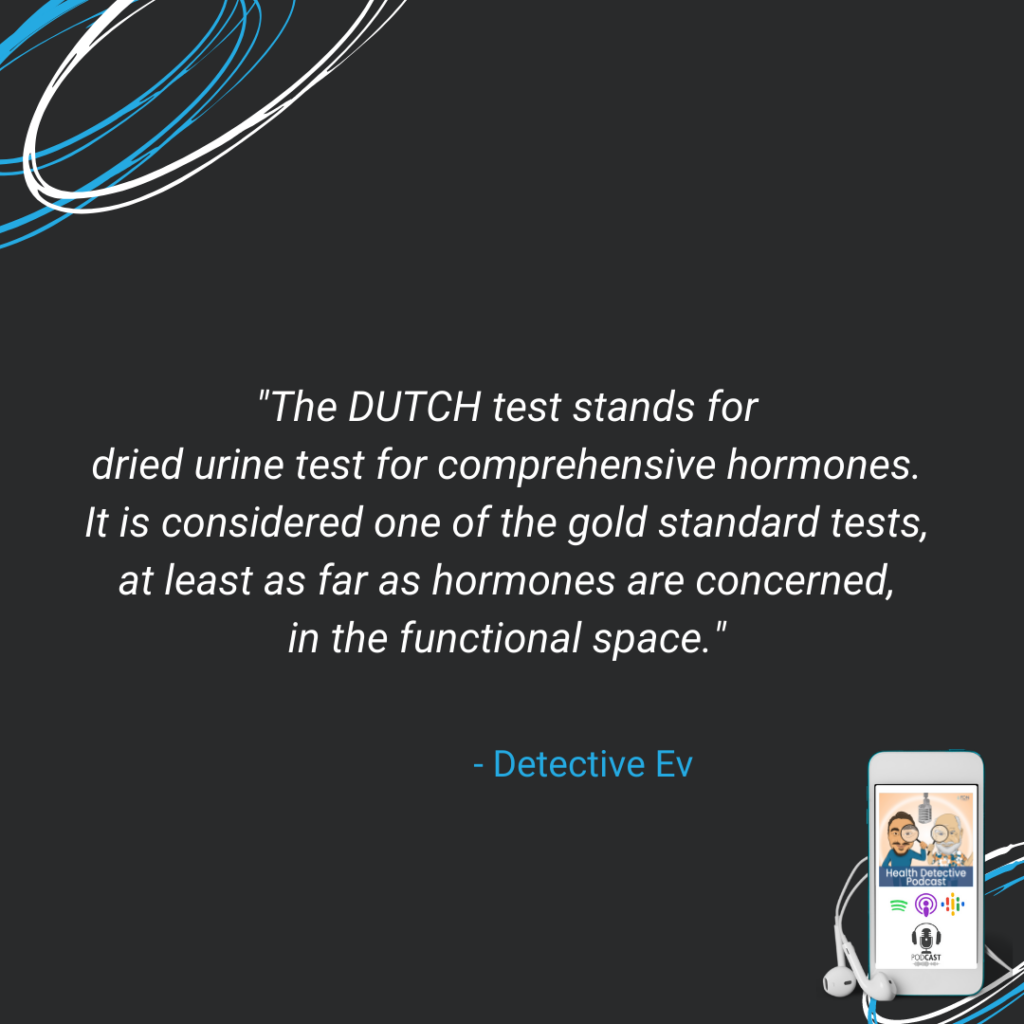
If you’re sitting there thinking, wow, this guy sounds like he is in a great mood, you would be absolutely correct. It is because we got to do another wonderful lab analysis video. The DUTCH test stands for dried urine test for comprehensive hormones. It is considered one of the gold standard tests, at least as far as hormones are concerned, in the functional space.
Now, we don’t actually teach this test in the main course. There are some bonuses for it. You can get it for free. It’s something that’s at the very end of your training. But we do not teach this in the main training. The reason I’m showing this to you guys is one, so you can continue to learn how we actually think as FDNs and how we analyze lab tests generally speaking. Because you can still learn a lot from this even if you’re not going to use this specific test.
But on top of that, you gotta understand a couple of things. You really don’t need this test to do FDN properly, and we have an advanced course on this. We have plenty of practitioners who use this test exclusively. I am not saying there is something wrong with it. I am saying that to do FDN properly, in my humble opinion, it is really not necessary 99% of the time.
FDN’s Core Principles Are Lifestyle Things
[00:01:28] Detective Ev: What happens is there are many people out there, one, they want to take their knowledge to the next level. I totally respect that. That’s fine. And two, they might have a demographic where the hormone stuff could be extra helpful to know.
A lot of people work with mid-forties women, if they’re going through menopause or are premenopausal, but you know about to get there perimenopausal type of thing, or if they’re trying to get pregnant and maybe they’ve had infertility issues. Yes, of course it can help to have every little tool for you in terms of helping this person get better. But at the end of the day, what it really comes down to is the lifestyle stuff.
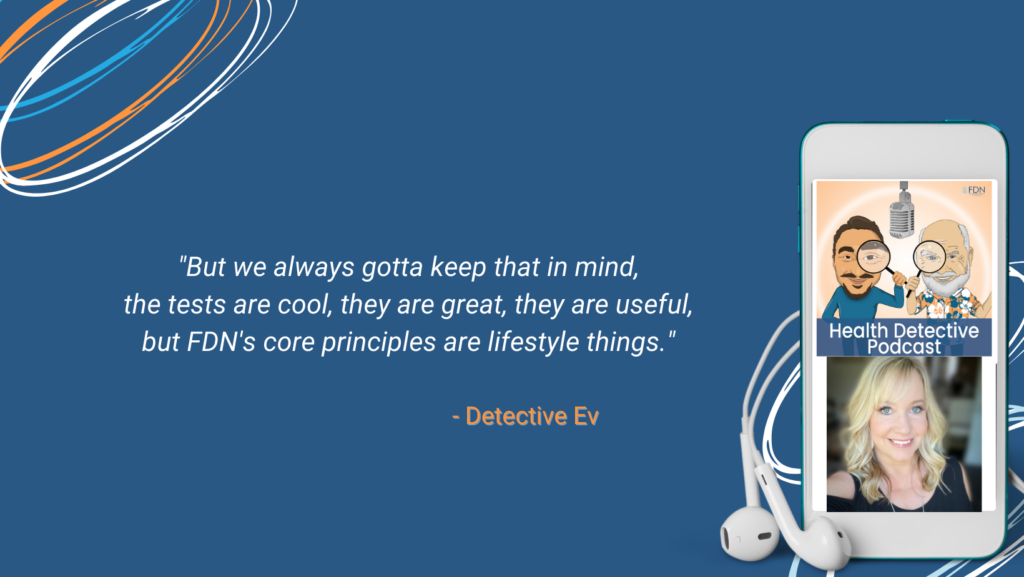
So, I’m not trying to discredit the podcast that you’re about to hear cause it is awesome. But we always gotta keep that in mind, the tests are cool, they are great, they are useful, but FDN’s core principles are lifestyle things. And I don’t think you need this test, per se, to get the results that you want with clients and even with yourself.
I will also add in, because I said there was two reasons that we don’t teach this in the main course. The complexity of the test itself would mean that we have to now add tens and tens of hours of extra training to the FDN course. I mean, we’re talking at least 30 hours plus in additional training, which means you’re going to have to pay for that and you’re already paying for the hormone stuff. And you don’t really need it to do FDN well. So again, we’re not stopping anyone from doing this.
Paralysis By Analysis Isn’t Necessary
We have a way underpriced advanced course. I think it’s beyond underpriced. I don’t really get why it’s the price that it is. And I love FDN. Obviously, I work for them. I think we should have that probably higher. But as of right now, at the time of recording this, it’s still like $500, which is ridiculous cause you get 20 hours plus of direct DUTCH training with someone who is very familiar with the FDN system and kind of knows what we do and how we do it.
It’s a perfect person to be teaching the course, to be honest. But that’s beside the point. The point is to add this into the main course would require a lot more money for people. It would require a lot more time. And again, for what we’re trying to do, it just isn’t a hundred percent necessary.
I know even when I say this, there’s a bunch of nerds out there just like me who are going to never stop learning, and you’re going to always want to add on more complicated things. I know this about you, and I know this about me, that is why we do podcasts like this. Enjoy the episode. Have fun with it, nerd out with it. But just keep in mind that you do not need to go to this level to be an effective FDN.
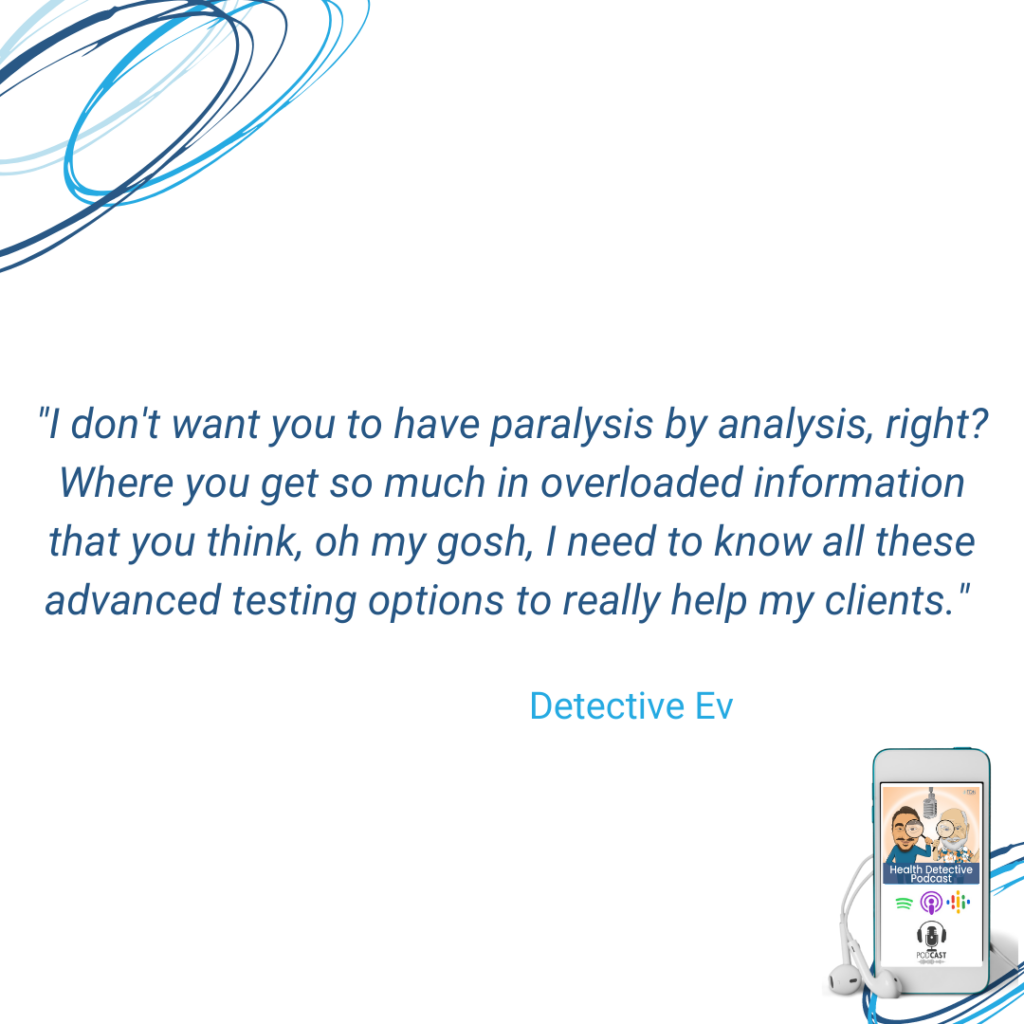
I don’t want you to have paralysis by analysis, right? Where you get so much in overloaded information that you think, oh my gosh, I need to know all these advanced testing options to really help my clients. That’s not the case, but it’s always good to add things on.
Without further ado, let us get to today’s episode.
Paula Reed – FDN Clinical Advisor
We are lucky enough to have with us Paula Reed, who is not only an FDN, but she is a clinical advisor at FDN. Now, for those that are not familiar with what that position is, cause we’ve had a few of them on before, these are the people that help the FDNs.
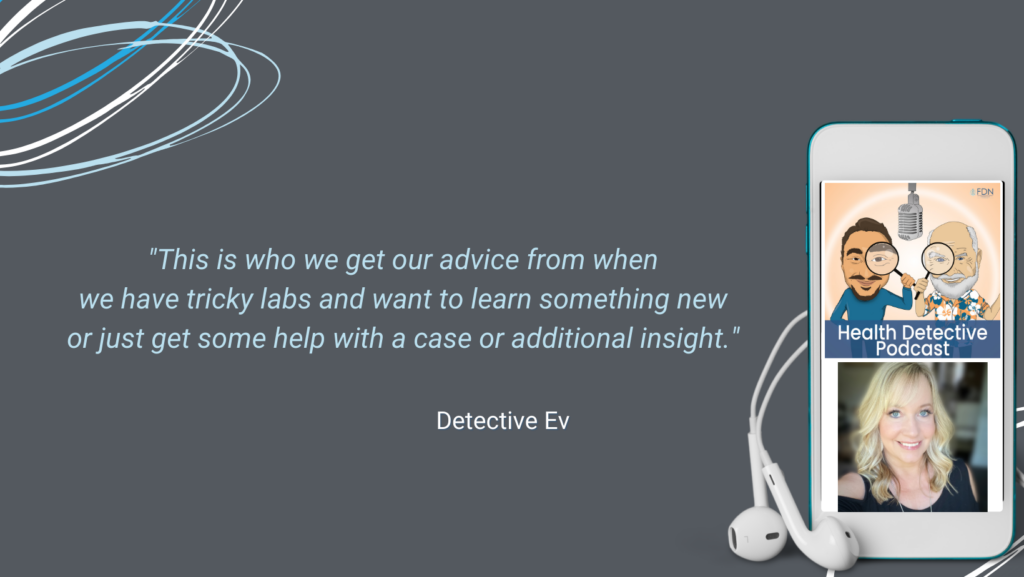
So, if you listen to this show and you’re already thinking, those guys and girls are pretty advanced with this stuff. This is who we look up to. This is who we get our advice from when we have tricky labs and want to learn something new or just get some help with a case or additional insight.
I always say, Paula, I feel like because of the nature of your guys’ additional job in doing this, no matter what happens, I always use those medical director consults. Because I’m like, there’s no way that they can’t catch something that I wouldn’t catch. At the very least, if you guys agree with me a hundred percent, it was still worth the time to get on the call and just realize, okay, cool, I am on the right track.
Today, what we’re going to be doing is actually diving deep into a lab. We’re continuing our series because you guys seem to be loving these and I enjoy it as well. This one I fully admit not every FDN has the same knowledge base with every lab, and this one is one I’m a little ignorant to.
Analyzing and Clinically Correlating the DUTCH Test Results
So, if you’re listening and you’re interested in the DUTCH test and you clicked on it because of the title, and you’re like, I don’t know that much. Am I good to go through this? Perfect. You and I are in the same boat and that’s why we have Paula. She’s going to help us out today. We have test results to share with you guys.
You guys will want to make sure to be on YouTube if you are not already. Of course, we always try to do our best here to make these something that you can listen to on audio because we know that our audience is mostly audio based. But this is a complex test, guys. It’s not Paula’s job to do every little thing on audio, so I would highly recommend hopping on YouTube if you can.
But if nothing else we will do our best to try to make this as clear as possible while we’re just doing audio. So, Paula, can you see the test results?
[00:05:44] Paula Reed: Yes, I can.
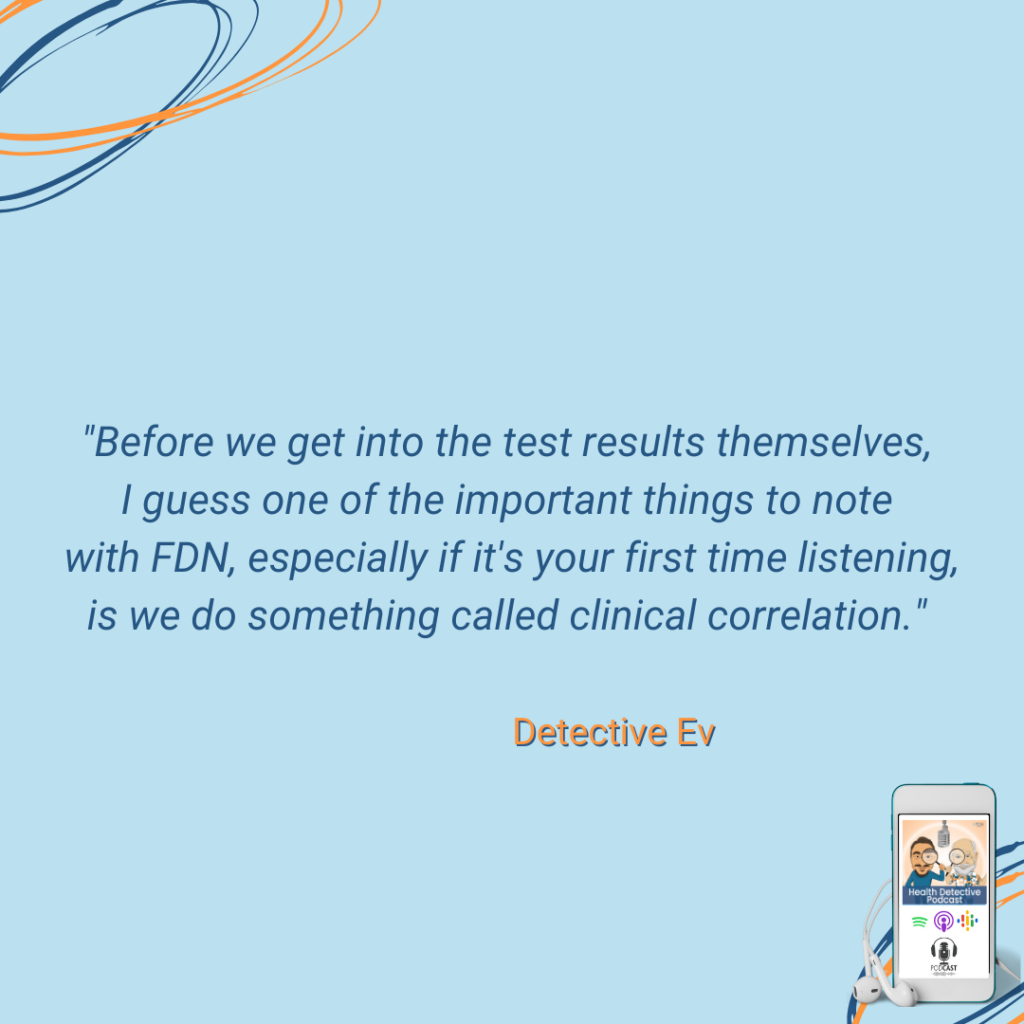
[00:05:45] Detective Ev: Thank you. Okay, cool. We will obviously not be seeing the client’s name today, but we do get to see that they are a 41-year-old female. Before we get into the test results themselves, I guess one of the important things to note with FDN, especially if it’s your first time listening, is we do something called clinical correlation. It’s different than diagnosing. We don’t diagnose or treat anything.
The DUTCH Test: Depression, Lack of Energy, Hair Loss
Diagnosing would be okay, Mr. and Mrs. Jones, your blood sugar was at X, Y, Z level, this number of times. So, we’re going to classify that as Type II diabetes. Whereas clinical correlation, at least one example of it would be, hey, we noticed that you have these mood swings at this time of the day, but your blood sugar, because maybe you’re using a glucometer or something, also was really high when you have those mood swings. That would be a clinical correlation.
When we’re looking at these tests, we’re never diagnosing something. That’s not what we’re doing. We’re trying to correlate it with what the client might be experiencing. So, to the degree that you’re able, Paula, cause I know that obviously we have to be respectful to people’s privacy. But what can we say about this client? What were they dealing with when they ran this test with you?
[00:06:43] Paula Reed: Awesome. Yes, this is a 41-year-old female. That’s kind of my population. I work with a lot of perimenopausal and menopausal women who are just starting to not necessarily feel like themselves.
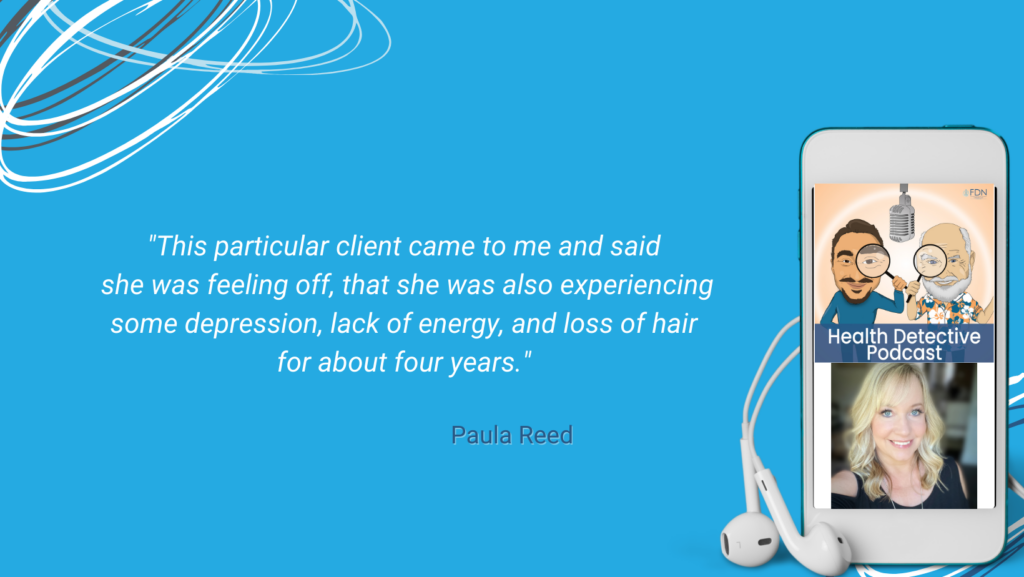
This particular client came to me and said she was feeling off, that she was also experiencing some depression, lack of energy, and loss of hair for about four years. That’s why she came to me, and we decided to run this lab as well as some others. We’re kind of doing this in baby steps. She hasn’t completed all of the labs yet, but this is the first one. This is a newer client’s that we just got back.
The DUTCH Test: Page 1 Overall Hormone Levels
[00:07:19] Detective Ev: Cool. Nice and fresh, I like it.
So, the first thing I’m noticing at the top, this is useful for me and to the audience, there’s a key here and it says how to read the results. When we’re looking at these little, almost complete circles, right? I mean, they’re not full but they’re these little circles. What is this here? Is this the reference range, I’m guessing? How does this work on this test?
[00:07:35] Paula Reed: On this first page, we’re just kind of seeing an overall view and a snapshot of the levels of the sex hormones, as well as the adrenal hormones. All of those circles, we refer to those as dial gauges. Between the two yellow stars on either side of those gauges, that’s the normal range. Then with the little needles on those gauges, that’s showing us where the levels are.

There’s another page, when we get to the next page, you’ll see all the actual breakdown of all of these metabolites. But for this, it’s just a quick glance at what do the hormone levels look like overall.
To give you an example on this one, with her estradiol, which is the strongest estrogen and progesterone, the dials are pointing to the same general area on their own respective gauges. And that’s what we want to see. This is actually a good presentation. A lot of times when women are entering perimenopause, we start to see that progesterone start to drop even before estrogen does. That’s why a lot of women become estrogen dominant at that time. It’s due to progesterone insufficiency.
The DUTCH Test: A False Low and Why
But in this case, her hormones actually look really good with estrogen, progesterone, very balanced. Now, I thought this was a good example of one possible, I guess con, of the DUTCH. Her testosterone is showing really, really low. I’ll show you on the next couple of pages why that is a false low of everything that the DUTCH test, and I personally love the DUTCH test. I do use it with all of my clients.
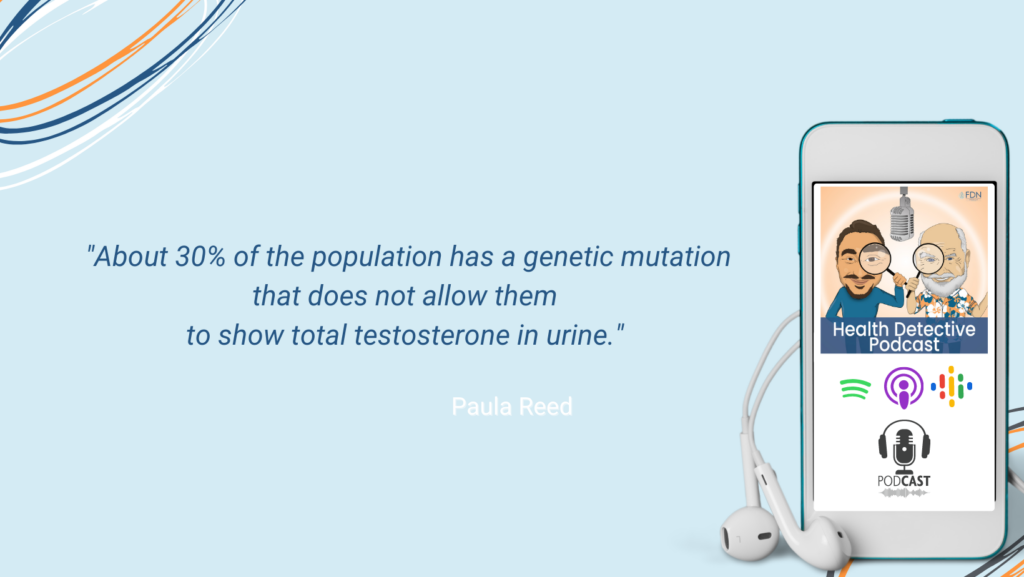
About 30% of the population has a genetic mutation that does not allow them to show total testosterone in urine. Blood is the gold standard for testing testosterone. It just so happens that people with Asian ethnicity tend to be, I guess, the higher population that has that genetic mutation.
This particular client has Asian ethnicity, another clue that this may not be correct. So, I asked her to check testosterone via blood to confirm, and of course her testosterone’s not really that low. Whenever I see low testosterone on a DUTCH, I will confirm with blood before doing any aggressive strategies to try and improve testosterone. It may not need improving, and hers actually did not.
[00:09:50] Detective Ev: That is so cool. This is why I love the world of FDN, right? Because it’s always reading between the lines and then reading between those lines as well. Obviously, we love the DUTCH, clearly you just said that you use it with every client.
But we can be objective here. If I ran this as an untrained professional, is there anything to acknowledge on this, that genetic mutation, or would I just be totally in the dark about that?
The DUTCH Test: Preferred Urine Testing to Measure Actual Cortisol Production
[00:10:12] Paula Reed: Actually, yes, the lab is really good. There are several pages that we won’t show on here, of where they will give you some hints and tips as the practitioner to help you interpret this.
Now, it’s not the same thing as like doing the FDN advanced course on stress and hormones. That is a wonderful course for learning all about DUTCH interpretation and ways to address the imbalances that we find. But there will be a notation on this lab saying, hey, you may want to double check this. This person indicated they were of Asian ethnicity and it’s showing low when it really shouldn’t, based on the other androgen metabolites, so you might want to double check that.
[00:10:48] Detective Ev: The lab is good at doing that.
And then I’m seeing in this adrenal hormone section, which we’re still on the first page for those on audio. As an FDN, this is something I’m very familiar with, right. These four cortisol patterns throughout the day. Looking at waking, morning, afternoon, and night.
My initial impression as someone who is not familiar with the test, but still has the knowledge as an FDN, I’m actually thinking, wow, this is not the worst one in the world by any means. But I feel like that waking was probably a little on the lower end, of course. I’m assuming that you would agree with that.
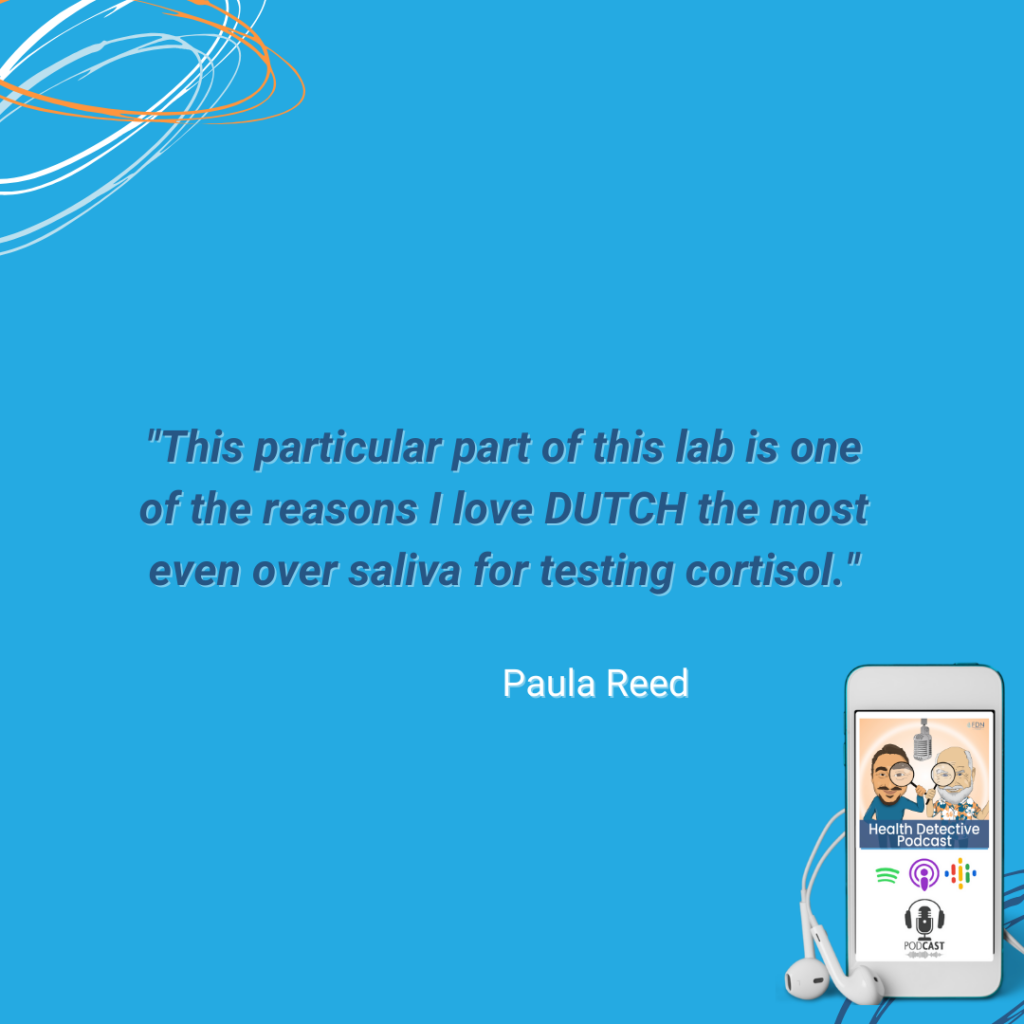
[00:11:17] Paula Reed: Absolutely. But this particular part of this lab is one of the reasons I love DUTCH the most even over saliva for testing cortisol. Saliva can give us some very valuable information, not knocking it at all. A lot of practitioners use it.
The DUTCH Test: A Discordant Pattern
But if you notice that gauge to the left that says 24-hour free cortisol, that is the same thing that we’re measuring when we measure cortisol with saliva, free cortisol only. And free cortisol is that free and available cortisol that can be used by the body.
Over to the right you’ll see that gauge that says metabolized cortisol. This is the difference between saliva and urine. With urine, we can measure actual cortisol production. What is free and available does not always match what is being produced. You can get a few more clues about other imbalances in the body by looking at the difference. In this particular case, you may notice that the dials on the gauges are not pointing to the same direction.
So, with the 24-hour free cortisol, which is what that daily free cortisol pattern graph is based on, it looks wonderful. She’s right in the middle, which is optimal. Anything trending to the right is trending high. Anything trending to the left is trending low, obviously. But where that needle is, it’s like right in the middle, maybe just a little right of center. That’s excellent. She’s got plenty of cortisol available to be used by her body.
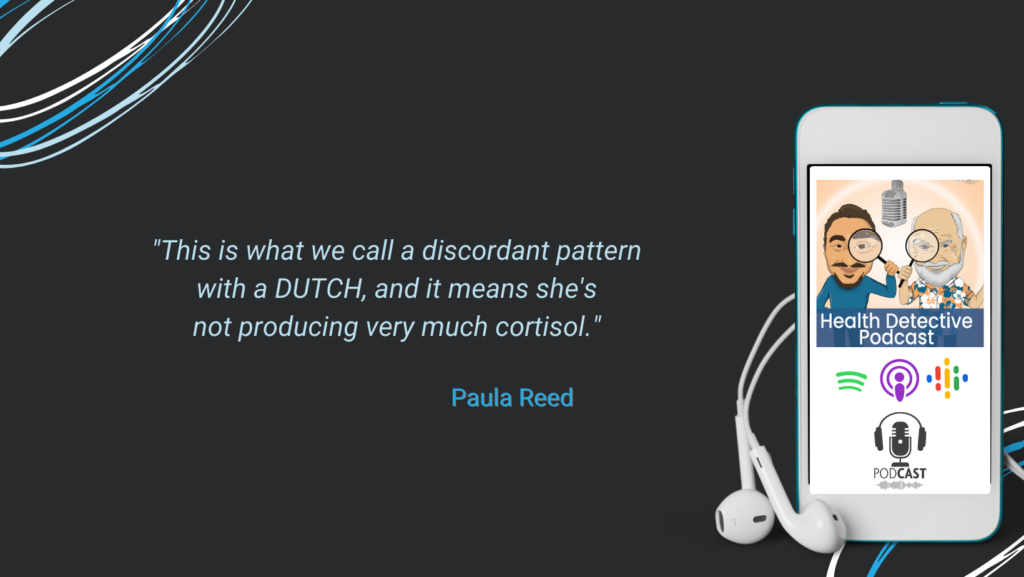
But if we look at where the needle is on the gauge for metabolized, her production is showing barely within the normal range. This is what we call a discordant pattern with a DUTCH, and it means she’s not producing very much cortisol. She has very sluggish clearance. Depending upon where the needles are on the gauges and where we catch this kind of discordance it may not even be an adrenal issue at all. It’s a clearance issue.
The DUTCH Test: Sluggish Clearance
In this particular case, because this had been going on for about four years before she was able to seek help for this, it’s become both. It’s a clearance issue and an adrenal issue because based on her production, she’s in the exhaustive phase. Based on what is available, it’s more compensatory phase, which means she’s doing okay with that. But we need to fix the issue that’s causing that discordant pattern.
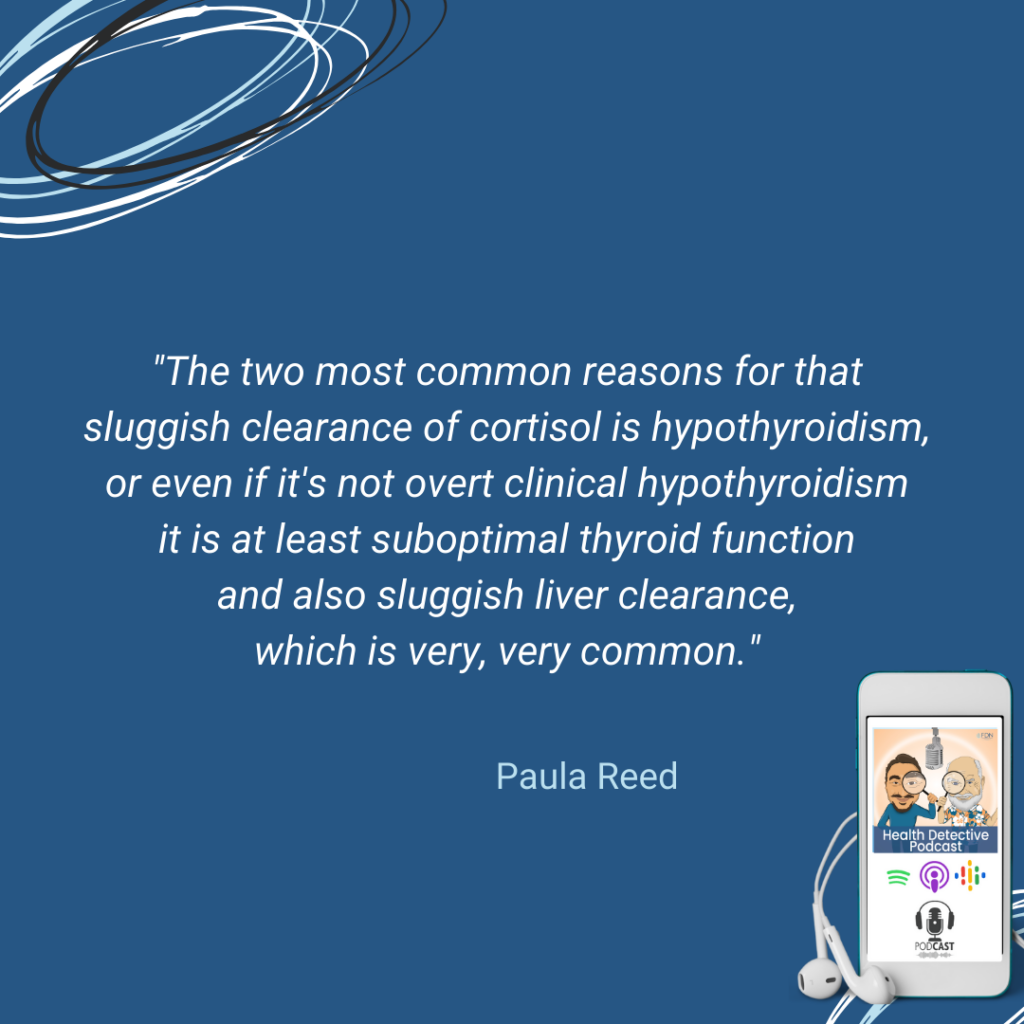
The two most common reasons for that sluggish clearance of cortisol are hypothyroidism, or even if it’s not overt clinical hypothyroidism it is at least suboptimal thyroid function and also sluggish liver clearance, which is very, very common. When people have issues with phase one or phase two liver detox, we see sluggish clearance of all the hormones, and this is the perfect example of that.
[00:14:02] Detective Ev: Okay, so a quick question, I could be completely wrong with this. Is the DUTCH a single urine sample or is it multiple urine samples?
[00:14:07] Paula Reed: It’s four samples, just like what we do with saliva. That’s how we plot that daily free cortisol pattern. That’s how we do that. So, it’s four samples throughout the day. They’re done a little bit differently, different times than what we do with saliva.
But believe it or not, there’s more than one DUTCH test. This is the DUTCH Complete, which is urine only, but there is a test called the DUTCH Plus where you use urine and saliva so that you get the most accurate cortisol pattern with the 24-hour free. They measure both saliva and urine, but this one is only urine. This is the one I use the most.
Saliva Vs. Urine Samples
[00:14:43] Detective Ev: Okay, cool. Let’s say we have all the money in the world. There is validity to doing the saliva with the urine. It’s not that one’s necessarily superior, it’s just that you would prefer one over the other if you only have the choice of one.
[00:14:53] Paula Reed: Saliva is typically considered the most accurate for plotting that cortisol pattern because if you do it according to the directions correctly, it should take you no more than about 10 minutes to produce a saliva sample. So that’s very spot on for producing that pattern.
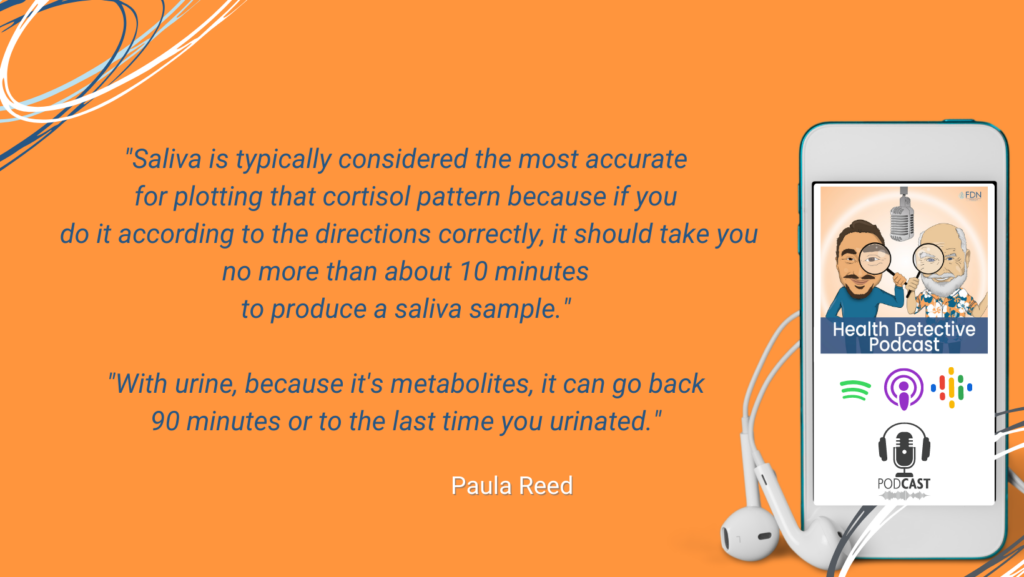
With urine, because it’s metabolites, it can go back 90 minutes or to the last time you urinated. So, we actually restrict fluid intake on the day that we do the saliva, so we have concentrated enough urine to measure the metabolites properly.
[00:15:24] Detective Ev: Got it. This makes so much more sense now that I know that there’s four markers. I was under the impression this was one single urine thing. I’m like, how the heck did they get this pattern with one. That was very confusing to me.
Paula Reed: Yeah. No, it’s four.
Detective Ev: Cool. The one thing I want to mention too, because obviously if people are listening to this, we know we have like many trainees that listen and of course they’re getting trained right now on the saliva tests only. One thing I will say as a practitioner who only has the knowledge in the saliva side is if you guys can’t tell, I mean, just by going through the first page of this, there’s an extra level of complexity to this.
I think this is what people really miss in the world of FDN. They will always ask, well, what’s the best lab?
What’s The Best Lab Test?
We could debate that all day.

But I know for sure that the best lab test is never going to be the one that you are not trained to analyze. If I don’t know how to use the test and interpret the results, it could be the best technology in the world, it is not the best test for Evan Transue.
Similarly, what’s super interesting is we have certain people, let’s take like Kendra Perry for example, who’s an expert in HTMA. I can make an argument that the HTMA is very valid in certain cases and maybe causes more harm than good in others or just isn’t as useful. But it depends on the practitioner.
You give an HTMA to someone like her, she’s going to make lemonade out of lemons with that. Like she will figure out a way to actually use that to its fullest advantage. And maybe myself being relatively new to HTMA, I’m going to completely miss things that she could find.
It’s not always about the test itself. I mean, at the end of the day, if all practitioners had the same knowledge, of course it would be about the test. But we need to remember it’s the one that we’re trained on. And salivary hormone testing, especially the way that we teach it in FDN, I believe is a much simpler barrier to entry for someone that might not have any training in biochemistry when they join FDN.
If you want to learn the DUTCH, we obviously have trainings for that. We got one of the better advanced trainings out there. But that’s the reason that we start with the saliva, is the simplicity of it. It’s still useful and it allows you to get in a little easier.
The DUTCH Test: Looking for Balance Between Cortisol & DHEA
[00:17:26] Paula Reed: Absolutely.
And as a clinical advisor, I actually get asked that a lot when I’m doing sessions, especially with newer FDNs who have just graduated. They’re like, oh my gosh, everybody’s talking about the DUTCH and I’ve gotta learn the DUTCH. Is that the best test?
I tell them exactly what you just said. The best test for you to use with your clients is the one you understand and that you can interpret and that you know how to help your client. I do consider this more of a next level test, and that’s why it’s not included in the course. It would make our FDN certification course so much longer, quite frankly, a lot more expensive.
It might actually be very intimidating to a lot of people as a first lab to learn. This is next level.
[00:18:06] Detective Ev: Sure. Would you like me to move to the next page?
[00:18:08] Paula Reed: I just want to point out really quick, that total DHEA production. Even with saliva, we always measure DHEA with cortisol because cortisol is a catabolic hormone. It’s very necessary in our bodies. Sometimes it gets a bad rap. Yes, it’s the stress hormone, but it is more catabolic to the body if you have too much of it.
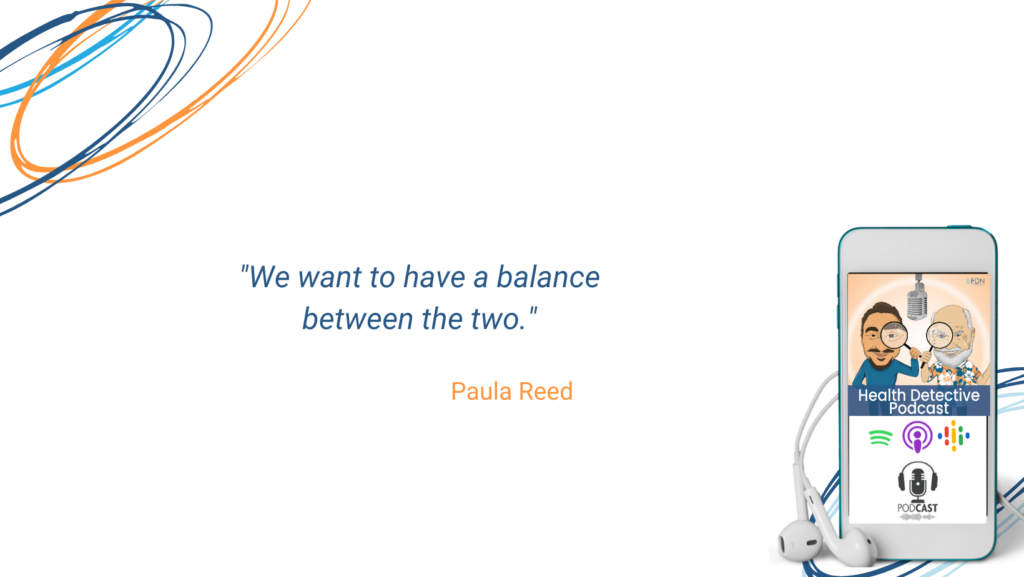
DHEA is that counter regulatory hormone that is anabolic. We want to have a balance between the two. And I just wanted to point out in this case, if we look at total DHEA and 24-hour free cortisol, her availability of cortisol and where her total DHEA production is kind of matchy, matchy. That’s a good thing. You can move to the next page if you’d like to.
The DUTCH Test: Looking for Dials Pointing in the Same Direction
[00:18:45] Detective Ev: I have one question cause I’ve heard you reference this now three times. Sounds like there’s something to the dials being in the same place. Is that correct?
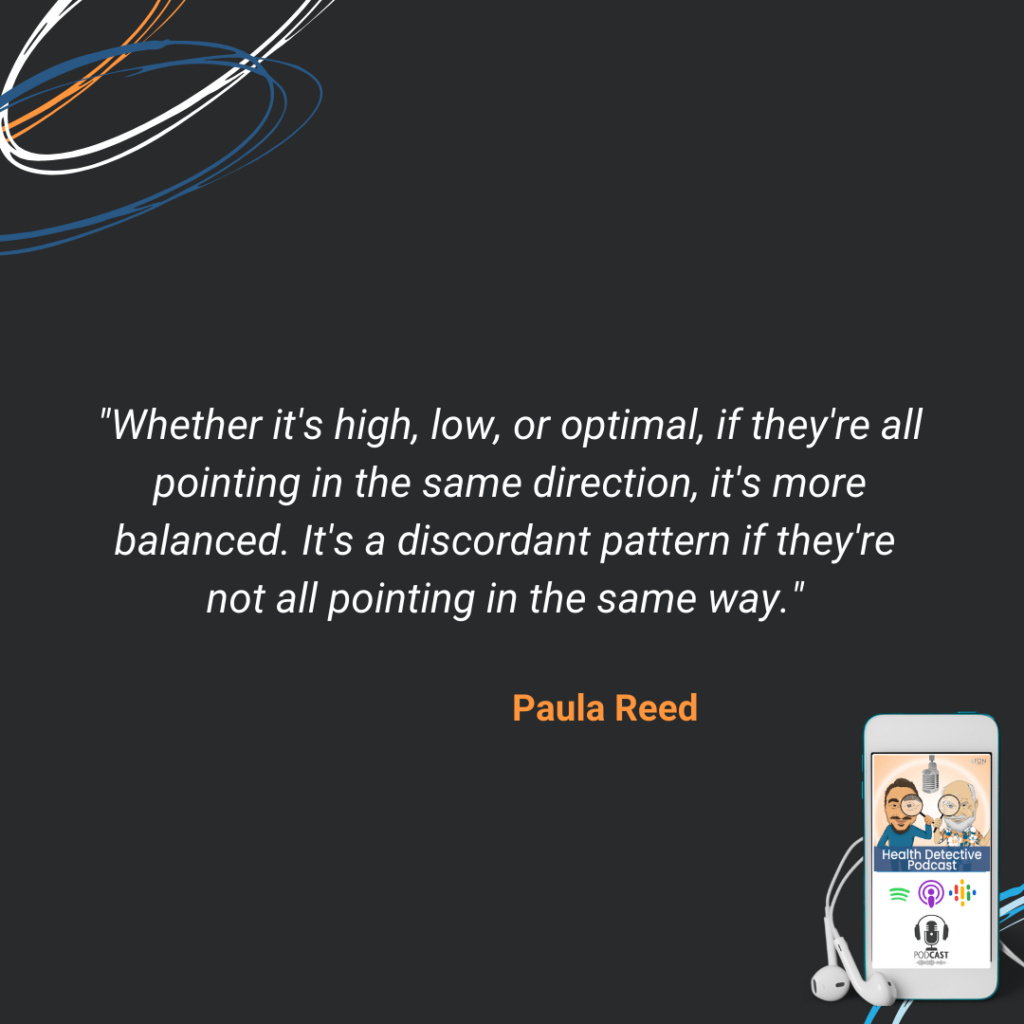
[00:18:53] Paula Reed: Yes, absolutely. In a perfect world like with 24-hour free cortisol and metabolized cortisol, and with total DHEA, you would want to see every dial on the gauge pointing in the same general direction, even if it’s not optimal. Whether it’s high, low, or optimal, if they’re all pointing in the same direction, it’s more balanced. It’s a discordant pattern if they’re not all pointing in the same way. Does that make sense?
[00:19:14] Detective Ev: Absolutely. And it’s just a nice little tidbit to have.
Now I can go into a test and have no other information. I don’t even have to have the reference ranges per se. I could say, oh, well, I remember what Paula said. Total DHEA and 24-hour free cortisol these are facing relatively similarly. And then, yeah, that metabolized cortisol is clearly the odd one out there. So, good little trick to know.
All right. When we go to the next section here, I’ll just go right to the ranges. There’s a lot of stuff here.
[00:19:36] Paula Reed: Yeah, I never spend more than about two seconds on this, whether I’m doing a clinical advisor session or working with one of my own clients, because all of these numbers and all of these ranges are going to be represented with those much easier to read dial gauges on the next page. So, if you just want to go to the next page. This just allows us to look at the ranges and the numbers, but it’s so much easier when I’m explaining to actually look at the gauges.
The DUTCH Test: Hormone Metabolite Results
Okay, this shows the breakdown.
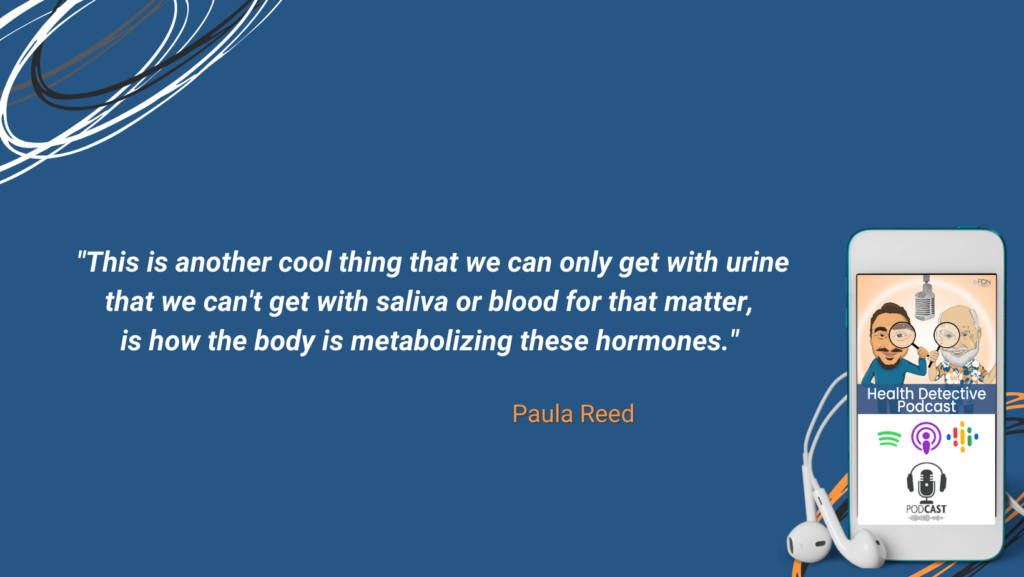
This is another cool thing that we can only get with urine that we can’t get with saliva or blood for that matter, is how the body is metabolizing these hormones. We got an overview of the levels on the first page, but now we can see the breakdown.
So, at the top of the page, it shows pregnenolone as our master hormone. And on the left side of the page, it’s showing how that metabolizes and breaks down with our androgens. You’ll see the little arrows going down.
There’s DHEA, there’s androstenedione, and then the two primary androgens there are etiocholanolone and androsterone. Looking at those needles on the gauges, again, both of those androgens are pointing in the same general direction. That actually doesn’t happen very often.
But that is showing us that, that little fan gauge at the bottom is 5a reductase activity, that tells us if the client is metabolizing their androgens in a more androgenic way or a less androgenic way. That’s important because if someone is very strong on the androgen side, they’re the person that’s more likely to have symptoms of excess androgens like oily skin, acne, hair loss, irritability, aggressiveness, mood instability, things like that.
Another clue that we can get, which I love with this, is about do we have any issues with any of the liver detox pathways? Look at the gauges on the etiocholanolone and androsterone and where they fall in that gauge. Look at the DHEA-S at the top, the sulfated, DHEA is what is actually available to be used by the body. Total DHEA is a combination of that sulfated DHEA, and those two androgens, the etiocholanolone and androsterone. They should all be pointing in the same direction and they’re not.
The DUTCH Test: Influencing 5a Reductase is Possible
You’ll see that DHEA-S looks lower on the gauge. That means that one of the liver detox pathways called sulfation is blocked, and that’s typically due to inflammation. So, now we know we need to support her liver. She’s having some issues with liver detoxification. That’s a wonderful clue to get just looking at the breakdown of androgens.
[00:22:10] Detective Ev: Very interesting. Yeah, I’m looking at those two dials. Now I have this in my head, so I appreciate this. I mean, those dials are dang near identical with where they’re at, pretty much. So that’s really good.
[00:22:19] Paula Reed: Absolutely.
[00:22:20] Detective Ev: I was just thinking, I wish I had run this when I was a kid. Because when you described the oily skin and the cystic acne or just acne in general, but it was cystic for me, I’m like, wow. I wonder what this was looking like as a teenager back in those days.
Cause I remember my DHEA when I ran like the BH205 back then. When I ran that, my DHEA was like three or four times above the higher end of the reference range. I was already doing a lot better, so I can’t even imagine what it would’ve been on this test back in maybe 10th or 11th grade Ev. That would’ve been crazy to see. Just a side comment.

[00:22:48] Paula Reed: Yeah. And that does correlate a lot. What’s really cool is there are strategies for influencing that 5a reductase activity with diet, lifestyle, and supplements. That can be altered. This is the systemic preference, but we can influence that. That’s good to know too.
The DUTCH Test: Progesterone for Sleep?
At the top of the right of that page are the two progesterone metabolites. What’s valuable about this one, especially when I’m working with women who are considering doing like bioidentical progesterone to support their hormones, a lot of women as they enter that stage of life, have difficulty sleeping.
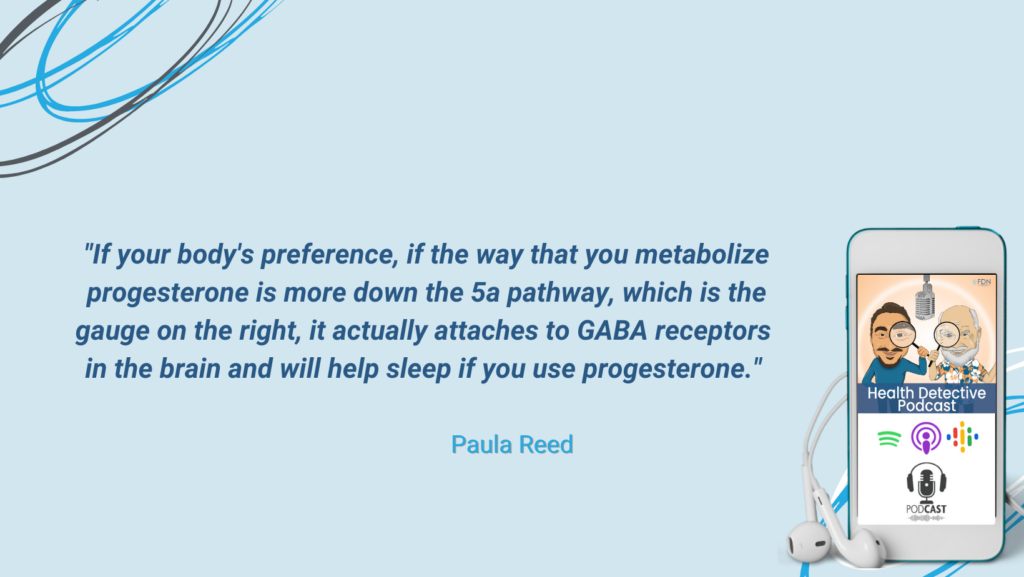
A lot of folks say, oh, well take progesterone to help you sleep. Well, here’s the thing. If your body’s preference, if the way that you metabolize progesterone is more down the 5a pathway, which is the gauge on the right, it actually attaches to GABA receptors in the brain and will help sleep if you use progesterone.
But if your body’s systemic preference is more the 5b pathway on the left, progesterone can still be very beneficial for hormonal balance, but it’s not going to help with sleep. So that’s kind of a fun little tidbit too.
[00:23:50] Detective Ev: Okay. So, I’m testing myself here. In her case, it would help with the sleep cause the one on the right is higher.
[00:23:57] Paula Reed: Absolutely. Very good.
Now if you want to scroll down just a little bit, this is the one that I find extremely helpful, especially with my clients who are doing bioidentical hormone therapy, whether it’s over-the-counter therapy or if they’re working with a licensed practitioner.
A lot of the licensed practitioners who prescribe bioidentical hormones are not using the DUTCH. They’re using blood to check levels, which is the gold standard, and that’s awesome. But using the DUTCH to look at how your body is metabolizing those hormones is really important to make sure that they are metabolizing down the healthiest pathways.
The DUTCH Test: The Breakdown of Hormone Metabolism
I’m going to try really hard not to get too technical here and just kinda give a broad overview. These gauges break down the three primary estrogens and then the three primary pathways as represented by that pie chart of how the body is metabolizing estrogen.
Actually, all the hormones are metabolized this way, but we’re using estrogen as the example, because that’s the most problematic when we’re thinking about hormonally induced cancers like breast cancer. While genes can be very important when it comes to breast cancer, most breast cancer is not the result of the defective genes. It’s because of this breakdown of how we are metabolizing our hormones.

So, with that pie chart, there’s the 2-OH, the 4-OH, the 16-OH pathways. I kinda look at these as the good, the bad, and the ugly.
So, the green and the 2-OH is the most protective pathway. That’s the good one. You’ll see expected percentages there, should be between 60% to 80%. My client’s was 83.9%, that’s awesome, cause the higher the better.
Over to the right you see 16-OH in blue. It gets called bad, but it’s actually a dual pathway. We need a little bit of estrogen to metabolize down that pathway because it protects us from osteoporosis and osteopenia. But when it gets too high, over the 30% there, it can help cancer grow. It doesn’t cause cancer, but if there are any mutated cells in your body, it can help it grow.
Phase One Liver Detox Pathways – Hydroxylation
That 4-OH pathway in the middle, that’s in red, that’s the ugly one. That’s the one where almost everyone is going to metabolize some estrogen down that pathway. But we want that to be as low as possible because that particular pathway, can create what are called cancer causing quinones. That’s what creates cancer.
So, I always want to see how my female clients are metabolizing estrogen, whether they’re on hormone therapy or not. But especially if someone’s considering hormone therapy, in my opinion, this should be done first. Because if your pathways are horrible, we want to correct that before you start adding estrogen or even testosterone, which can aromatize into estrogen into your body.
[00:26:43] Detective Ev: When you say, for this red one, as low as possible, I mean, it still says the expected percentages are 7.5% to 11%. Just because something’s expected though, doesn’t mean that it’s ideal. So, are you saying that in theory even below 7.5% would be good, or is that incorrect?
[00:26:57] Paula Reed: Below seven would be optimal. If it were zero, that would be optimal. I’ve just never seen that.
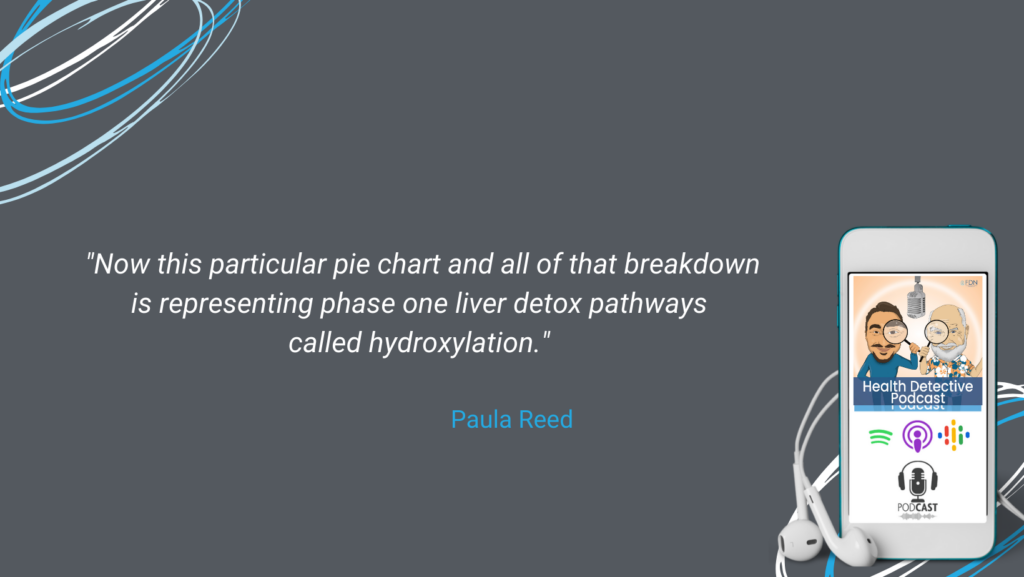
Now this particular pie chart and all of that breakdown is representing phase one liver detox pathways called hydroxylation.
When we scroll down a little bit and we look at the rest of the dials and that fan gauge at the bottom of the page, that’s phase two of this estrogen metabolism, methylation. I’m sure a lot of people have heard of methylation and there’s more than one methylation pathway, but this is the hormone methylation pathway.
Phase Two Detox – Methylation
Even if phase one is not stellar, hers actually is, but even if it’s not, phase two can kind of mop up those cancer causing quinones if methylation is high.
In her particular case, we look at that fan gauge over to the left and see how the red needle is leaning to the left for low. That means it’s a good thing she’s got really stellar phase one because her phase two is poor. She is not methylating well. Now this lab won’t tell us why necessarily, although we can get clues on the last page when we look at organic acid markers. There are co-factors for methylation, like vitamin B12, B6, glutathione, other nutrients. If you’re low in those, that can be why methylation is low.
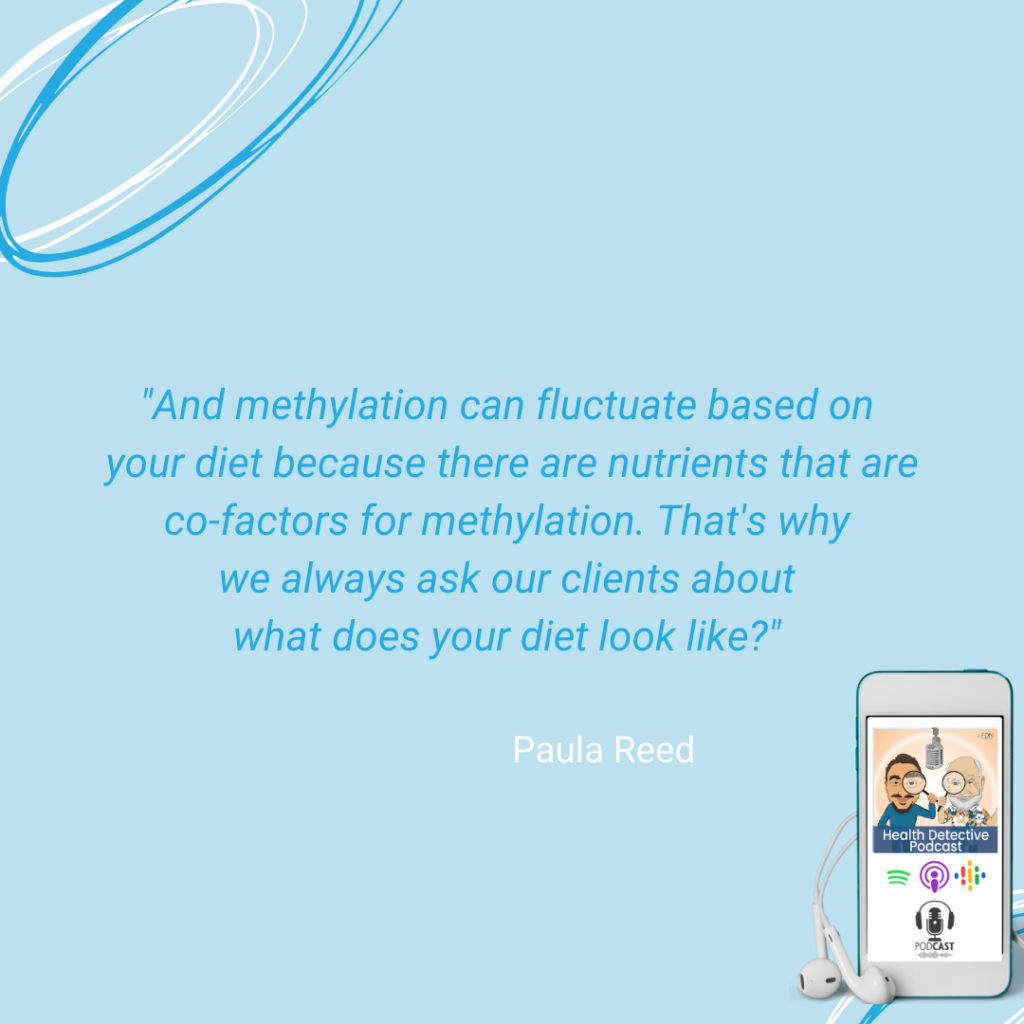
But we also know some people just have genetic mutations that make them poor Methylators. I’m actually one of those people. There can be a variety of reasons. And methylation can fluctuate based on your diet because there are nutrients that are co-factors for methylation. That’s why we always ask our clients about what does your diet look like?
Is this a standard American diet? Are you eating real whole foods? There are so many things that can influence this. That’s why you need all the information, like you mentioned correlation earlier.
[00:28:43] Detective Ev: So, this is saying in theory what it does, right? Cause I’m looking at COMT, I’m like, okay, well that could be a genetic SNP. This is not testing for genetics, obviously.
The DUTCH Test: Hints of Genetics
[00:28:49] Paula Reed: Exactly. No, not at all.
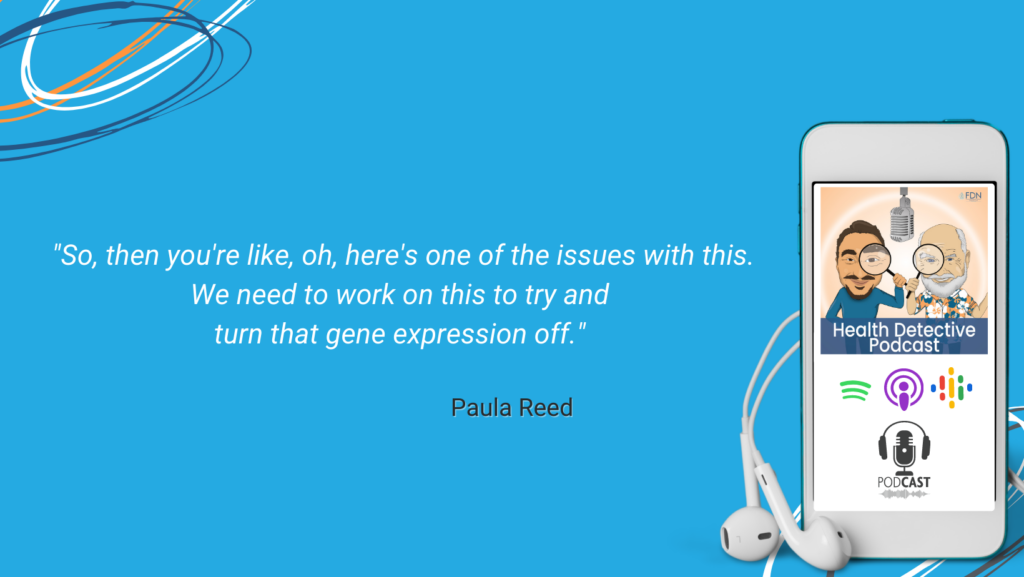
It’s mentioning this though, and there are several areas, like if you look at the red and green arrows and you see things like CYP1A1, all of those things are genes. Because if you wanted to investigate someone’s genetics, cause a lot of people are doing that kind of testing now, if something doesn’t look good in any of these pathways, you can go back and you know which genes correlate with those pathways. So, then you’re like, oh, here’s one of the issues with this. We need to work on this to try and turn that gene expression off.
[00:29:19] Detective Ev: Very cool. Just really quick before we continue to scroll down. As someone who is very new to it, just overall with the impression that I’m getting from you and the things with the dials and stuff like that. A very general interpretation, clearly there’s things to work on, but I am sure you see clients that are way worse than her overall. Is that correct?
[00:29:37] Paula Reed: Most definitely. Overall, this is not bad so far. Her phase one is stellar, but because her phase two on this particular page is poor, I’m always going to make recommendations to make sure that we can optimize methylation as much as possible. But yes, you’re right. This is not bad overall.
[00:29:55] Detective Ev: Got it. Keep moving it down?
Paula Reed: Sure.
Detective Ev: Oh, great. A bunch of other crazy markers, although a little less intimidating than the other one, that’s for sure.
The DUTCH Test: Importance of Creatinine A (Waking)
[00:30:03] Paula Reed: Yes. So, this one again, is a breakdown of all the gauges we’re about to see on the next page.
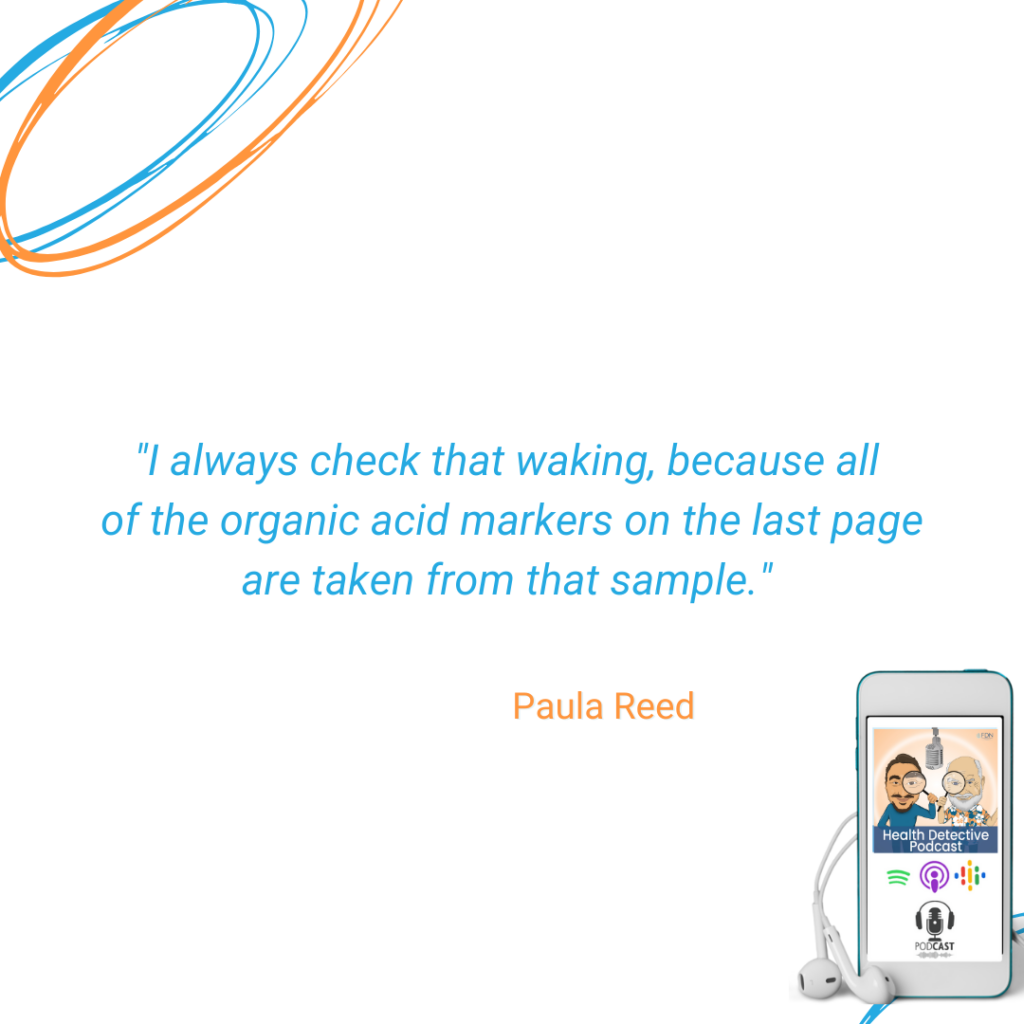
Now, one thing I will point out, I always check out that very top marker creatinine A (Waking). As I mentioned before, we ask folks to restrict fluids on the day of testing, so their urine is not too diluted. I always check that waking, because all of the organic acid markers on the last page are taken from that sample. If it’s diluted, I know that I need to adjust just a little bit when I’m looking at it.
But this one is within range, so that’s good.
[00:30:32] Detective Ev: Okay, cool.
[00:30:35] Paula Reed: With this one, we get a little dial gauge on melatonin production, which also gives us a little window into gut function because 75% of our melatonin is produced in the gut.
Hers actually looks really good here. She does supplement with melatonin, a very low dose, so that can influence this a little bit. But when we see melatonin really low, I know that there’s some kind of dysfunction going on in the gut. Stool testing is an absolute must.
Again, we see the total DHEA production gauge, metabolized cortisol. We can see that discordant pattern there because her actual cortisol production is again falling in that exhaustive phase because of her sluggish clearance.
Now we have a fan gauge about more cortisone or more cortisol. This is showing from her brain the systemic preference that her body is trained to influence, do we want more cortisone or more cortisol?
The DUTCH Test: Cortisone or Cortisol?
Cortisone is the inactive form of cortisol, and our bodies can interconvert between the two as needed because our bodies are smart and adaptable, it tries to do what it thinks is needed.
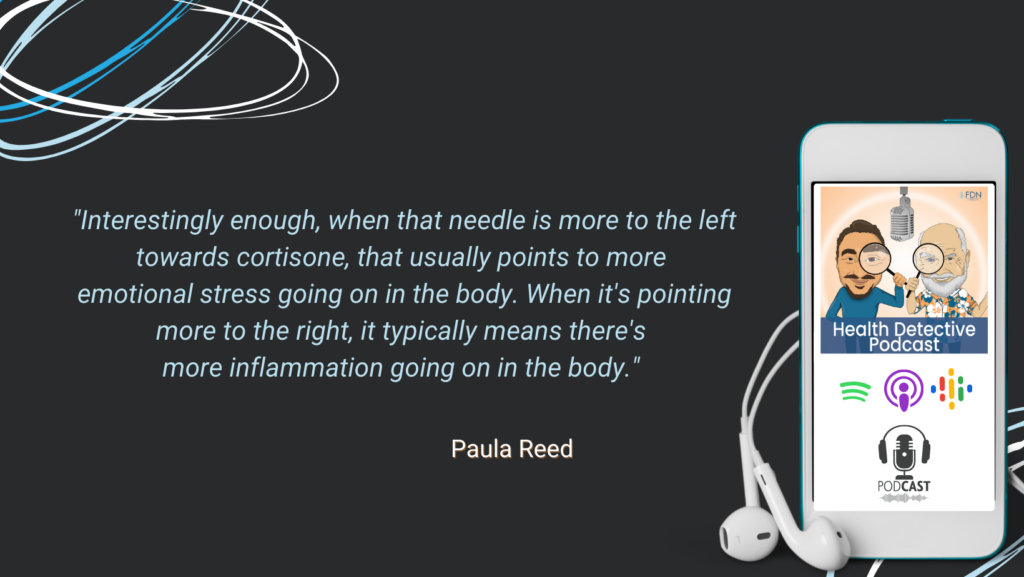
But interestingly enough, when that needle is more to the left towards cortisone, that usually points to more emotional stress going on in the body. When it’s pointing more to the right, it typically means there’s more inflammation going on in the body. That’s a fun little clue to get as well.
Then when we scroll down and it shows circulating free cortisol, we get those needle gauges of a daily free cortisone pattern and the daily free cortisol pattern. A lot of times those needles do not match and that’s okay. But one thing that we can look at, sometimes when someone has a very strong cortisone preference, we may see more 24-hour free cortisone than cortisol. That would indicate they’re deactivating too much, and that’s when we would use something to try and prevent that from happening so frequently.
Licorice root happens to be the number one thing we use. It preserves the half-life of cortisol. In this case, we don’t need to do that because her 24-hour free cortisol is actually in a really good place.
But the system preference doesn’t always match what we actually are showing once we excrete it in the urine, if that makes any sense at all.
[00:32:49] Detective Ev: Cool. The licorice root on a side note, that was like one of the weirdest things I’ve ever learned in FDN. It’s like, why? Like why does that help so much with this particular thing? It’s kind of cool how these otherwise natural things can do so much for the human body when used intelligently.
The DUTCH Test: Nutritional Organic Acids Markers
Paula Reed: Absolutely.
Detective Ev: Are we good to keep scrolling?
[00:33:02] Paula Reed: Yeah. I think we’re ready for the last page. This is one of my favorite parts as well. It’s the organic acids markers. And just three of these markers were new, just kind of added within the last few months. But these are what they are, what they represent, and why they’re tested.

We look at things like vitamin B12, vitamin B6, glutathione, because as I mentioned earlier, those are co-factors for methylation. Sometimes when we see these out of range, we get a clue. Okay, that may be why methylation is poor. In her particular case, all of those are within range. So that’s a good thing. But then we are like, okay, we don’t know why methylation is low. She likely has a genetic issue there and we still want to support that.
All right. The biotin marker is included because biotin is another B-vitamin. A lot of people complain about hair loss. When biotin is low, that can be one of the reasons we have hair loss as well as hypothyroidism, poor digestion, malabsorption. There’s a lot of different reasons. Hers is his within range.
The gut marker, the indican, this is another one that we use with another FDN functional lab with Fluids IQ. Measuring indican is an indication of potential like protein putrification in the colon if we’re not digesting well. This is just a newer marker that was added here. The biotin and the gut marker, indican, are the two of the three newer ones.
The DUTCH Test: Neurotransmitter Markers
I also love the fact that they show the neurotransmitter markers because so many folks do talk about things like depression, anxiety, mood instability.
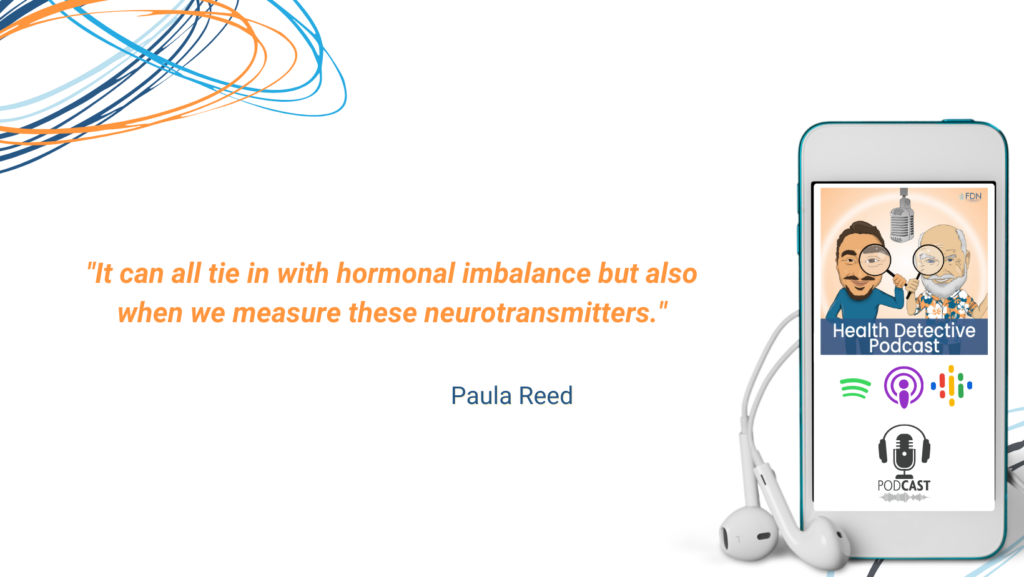
It can all tie in with hormonal imbalance but also when we measure these neurotransmitters. Like her dopamine is in the low end of the range. It’s not out of range, but in the low end of the range. One of her main complaints was depression.
If you’re not producing enough dopamine that can cause depression and or anxiety. Some people have both. What would lead to this in this particular case, her HPA axis dysfunction is very suspect because her metabolized and free cortisol do not match. So that’s a form of HPA axis dysfunction.
I also recommended that we do more investigation into her gut. She’s doing her stool testing now. Because sometimes if you’re not digesting or absorbing, that’s another issue.
Vitamin B6 deficiency is another issue. But when we look at her vitamin B6 markers, they look good.
This neuro inflammation marker, quinolinate, is the other new marker. I love this one because it points to more neuro inflammation in the brain. So, especially if we have a client that’s talking about a lot of brain fog, short-term memory problems, word recall, things like that, we can get some clues about that with this. That also ties to vitamin B6 as well as protein digestion.
The melatonin is showing in the height of the range. That’s not necessarily a problem. I actually just saw a DUTCH yesterday during a clinical advisor session where the melatonin was 171,229. That’s exaggeratingly high. She was supplementing with 30 milligrams of melatonin and didn’t skip it for the two days prior to the test. So, there was a lot of circulating melatonin in her urine.
The DUTCH Test: Melatonin & Oxidative Stress Markers
[00:36:07] Detective Ev: That’s a lot man, geez. That would not make me comfortable.
[00:36:09] Paula Reed: No, I actually asked the FDN to contact the lab and double check that because that’s the highest I’ve ever seen. 18,000 was the highest I’ve ever seen prior to that. That was very skewed.
But here’s the thing, when our body, our mind, our brain is telling the body to keep producing melatonin, melatonin is a very potent antioxidant. Sometimes that’s also indication that there might be something crossing the blood/brain barrier. There may be some toxicity, heavy metal toxicity, self-infections, things like that. And that often goes along with quinolinate if it’s really neuro inflammation marker.
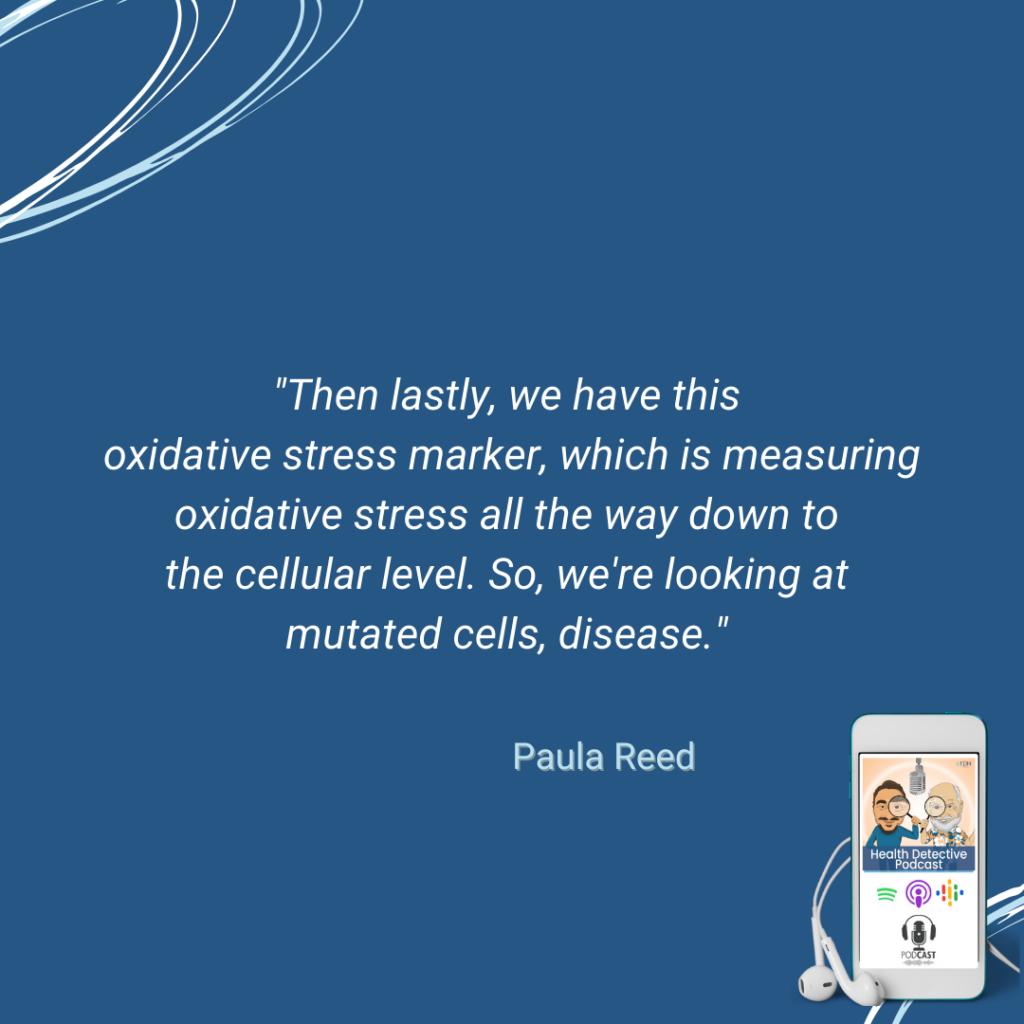
Then lastly, we have this oxidative stress marker, which is measuring oxidative stress all the way down to the cellular level. So, we’re looking at mutated cells, disease. It can also be elevated if someone has just had surgery, cause that’s tissue damage if you’re cutting into someone’s body or an injury like a torn rotator cuff, things like that.
But I’d like to look at those ranges, and I do correlate it with age as well. A younger person should have lower oxidative stress. The longer we’re on this earth we’re going to have a little bit more because we’ve been on this earth for so long and it’s kind of a toxic world.
So, that in a very quick nutshell, are all those organic acid markers.
[00:37:21] Detective Ev: I have a quick question because I feel like when I have thought about DUTCH in the past and I knew the organic acid markers were on here, I just didn’t know like which ones it was.
Where Do Organic Acid Markers Fit into the Bigger DUTCH Picture?
I’m thinking about this like, all right, it’s supposedly a hormone test. That’s what my impression has always been. Where do these organic acid markers actually come into the bigger picture here? Because listen, I use organic acids testing sometimes. I have some training in it. But at the same time, I also know like anyone that trains in organic acids is the first one to tell you that this is not the most accurate testing in the world, especially when we’re talking about the certain vitamin metabolites.
So, how does this fit into the big picture of the DUTCH for you?
[00:37:57] Paula Reed: Again, when we are going through the DUTCH and we’re seeing things like poor methylation or when we have a client who’s talking about mood instability, depression, anxiety, all of these markers and I want to touch on something like with a vitamin B12 and vitamin B6. These are not direct measurements of those vitamins. These are the measures of organic acids that will be out of range in the extreme likelihood that you have a deficiency of those vitamins.
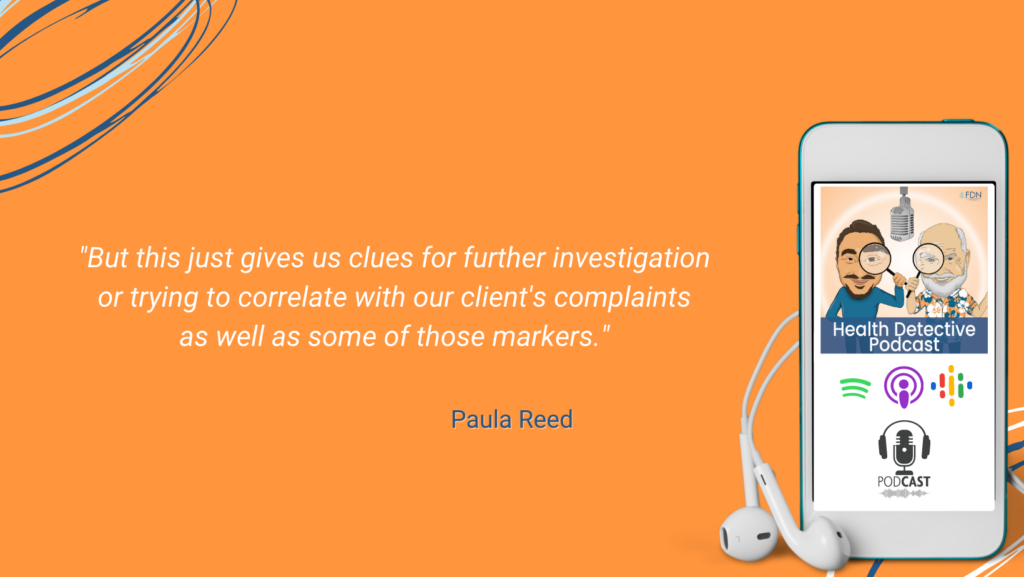
So, you’re right, it’s not a direct measurement. If someone wants that, they really need to get blood labs, that’s going to show you the direct measurement of those particular vitamins. But this just gives us clues for further investigation or trying to correlate with our client’s complaints as well as some of those markers.
Again, if someone shows poor methylation like she did, I’m going to look at the vitamin B12 and B6 markers and glutathione because all of those are needed co-factors for proper methylation.
Correlating Markers with Symptoms
Like in this case, even though her vitamin B12 and B6 looked okay, I still recommended a methylated B complex for her because this isn’t the end all be all. And knowing that methylation was low, I just feel like I know you can’t really over supplement with B vitamins, they’re water soluble.
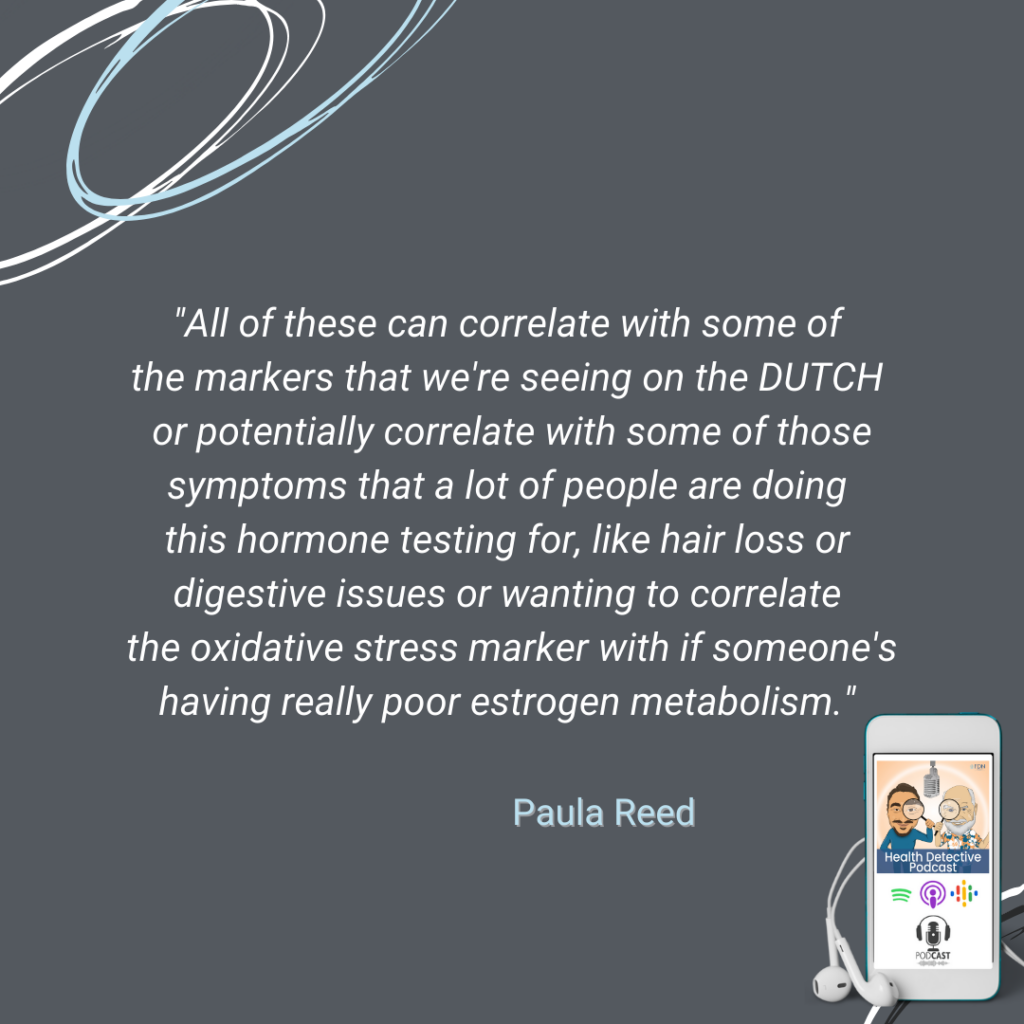
All of these can correlate with some of the markers that we’re seeing on the DUTCH or potentially correlate with some of those symptoms that a lot of people are doing this hormone testing for, like hair loss or digestive issues or wanting to correlate the oxidative stress marker with if someone’s having really poor estrogen metabolism.
I’m going to tell them they need to see a doctor, if oxidative stress is really high. If you haven’t had a mammogram, get a mammogram or see your gynecologist. Whatever is needed.
[00:39:42] Detective Ev: All right. That actually makes sense. And that’s kind of interesting.
[00:39:45] Paula Reed: That’s the end of it.
Yeah. The rest are notes from the lab about things that they just want to alert you to. For example, that low testosterone being, hey, you may want to double check that with blood because it looks like it may not be accurate.
[00:39:59] Detective Ev: Very cool. All right, so I’ll kind of just scroll through here really quick for you. Obviously, all these tests tell you how to read it and stuff. I mean, that’s not going to teach you how to do it in the way that you just did it for us, but still pretty cool.
I will stop sharing then. That was actually and relatively good timing too. I have a couple quick more questions just general questions now.
The Foundation of FDN is D.R.E.S.S.
So, with this client, again, we acknowledge that this is probably not the worst test in the world, especially compared to some of the people that come and work with us at FDN. And I know in the beginning we weren’t necessarily going to talk about like huge action steps, and we don’t have to per se.
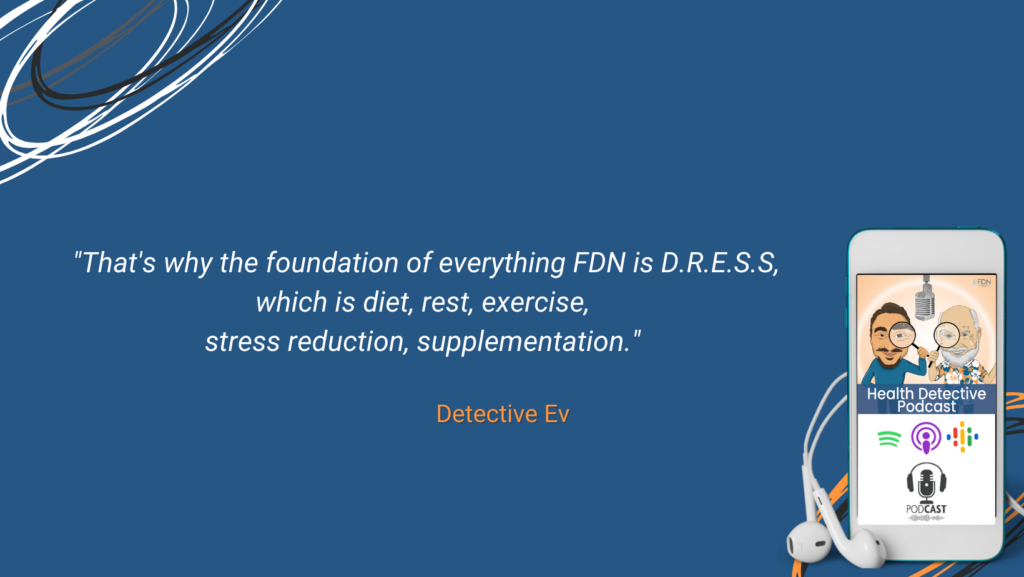
But I am kind of curious cause I think people want to know, like when they see some of these things out of whack, they kind of want to know what do FDNs do? I’ll just put the disclaimer on that. First and foremost, we always focus on lifestyle. That’s why the foundation of everything FDN is D.R.E.S.S, which is diet, rest, exercise, stress reduction, supplementation.
I know supplementation’s not lifestyle per se, but our modern world has so many deficiencies in it that certain basic supplements kind of are lifestyle nowadays. I don’t know how you’d get away without taking some type of additional nutrients.
I don’t know how you’d really get away without probably wanting some type of digestive support, especially if you’re on the go. Like for me, I’ve just decided to use that indefinitely. That’s the one supplement I keep taking. So, what are the recommendations outside of the, hey, Mr. and Mrs. So-and-so, you need to slow down.
What are the other recommendations for a person like this?
[00:41:14] Paula Reed: I can tell you specifically with her because she had that sluggish cortisol clearance, for example, she had never had a full thyroid panel. So, I recommended doing that. Her doctor would not agree to do it, so I ordered the labs. I have the ability to do that and am actually very fluent in thyroid labs. I was able to work with her on that.
The DUTCH Test: Paula’s Recommendations for This Client
She did not have actual clinical hypothyroidism. But what I love about a full thyroid panel is I could see she had suboptimal thyroid function with the most metabolically active thyroid hormone, which is free T3. So, we actually needed to support some nutrients in her body to improve her thyroid function.
With that really, really exhaustive phase with the cortisol, I actually recommended adrenal glandulars for one month just to support her adrenals while we worked on the sluggish clearance so that would bring that into more balance there between the free and the metabolized cortisol. I already mentioned like the methylated B complex. That was really, really important.
And I did actually recommend liposomal glutathione just for 30 to 60 days to support the liver because we did have a clue there that sulfation was struggling a little bit. Glutathione is wonderful for just supporting the liver overall, so I recommended that as well.
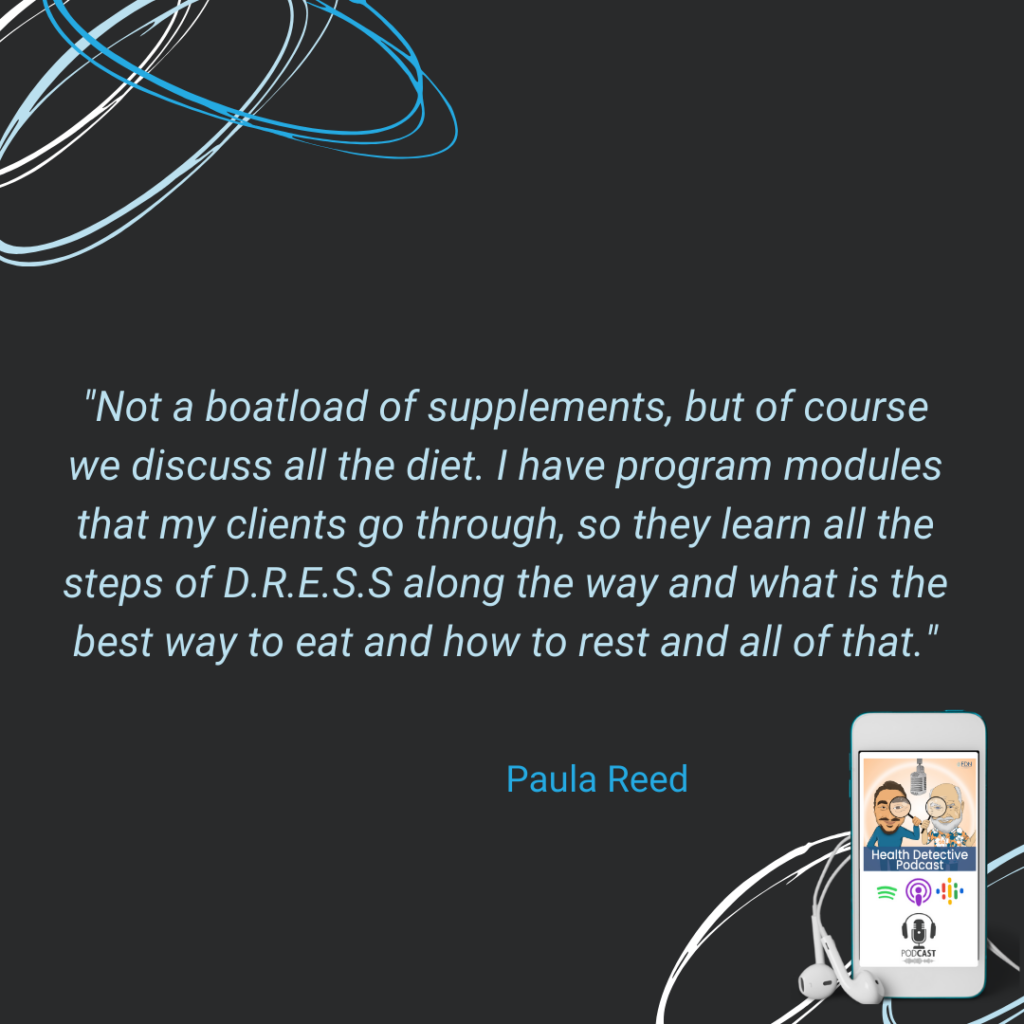
Not a boatload of supplements, but of course we discuss all the diet. I have program modules that my clients go through, so they learn all the steps of D.R.E.S.S along the way and what is the best way to eat and how to rest and all of that. She actually had a really good diet to begin with.
She’s very, health conscious. She just was struggling with some of those symptoms for a few years and that’s why she came to me. She was a referral from another client.
[00:42:46] Detective Ev: All right. Very interesting. This is very typical in the world of FDN. We might find some things that we can recommend, like other tests, like, hey, you might want to get this checked, not necessarily, but definitely can probably do that.
FDNs Help the Hard Cases and Guide to Next Level Health
I feel like the hormone tests and especially genetic testing, not that we teach it in the main course, but these are tests that all the time kind of imply other things that we could possibly do for the individual. Like genetic testing’s all about what other things can you basically run or what would you benefit from? That’s what I found at least.
So, this person, yeah, we’re going to address the lifestyle stuff. We’ll have this additional supplementation in the meantime. And we’ll help her course correct and kind of get to where she needs to go.
Now, it’s interesting because her results, since they are not the worst in the world of FDN, is also a little validating for the work she clearly has done. It can be as helpful as it is validating. Because for her, it’s like, all right, you’re still one of the better clients out there, trust us. But here’s how we can course correct and get you to that next level.
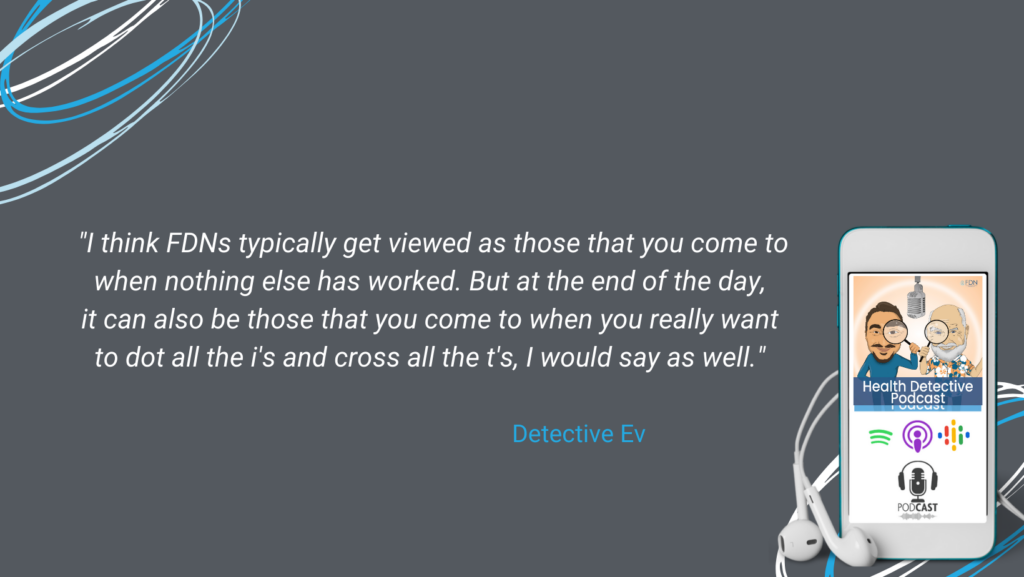
I think FDNs typically get viewed as those that you come to when nothing else has worked. But at the end of the day, it can also be those that you come to when you really want to dot all the i’s and cross all the t’s, I would say as well.
[00:43:47] Paula Reed: Exactly.
[00:43:48] Detective Ev: This was really fun. Are there any final things you have to say, anything we didn’t touch on? I feel like your overview was great. I’ve never actually had a clinical advisor consult with you, but I mean this seriously, you have the perfect demeanor and way of speaking for a teacher, so it’s really cool. I feel like that’s awesome that they have you in that position.
Where to Find Paula Reed
[00:44:06] Paula Reed: Thank you. I love being a clinical advisor. I do love educating, mentoring, and supporting my fellow FDNs. Especially, newer practitioners come into a session, they’re just getting started and sometimes it’s a little intimidating. They’re afraid that they don’t know what they’re doing.
And I love encouraging other practitioners, yes, you do. You know what you’re doing. So, I love it.
[00:44:27] Detective Ev: Oh, Paula, really quick, one last question for you. Where can people find you if they want to work with you? If they’re listening today and being like, all right, Paula knows her stuff. I need to work with her as an FDN. Who do you help? Who’s your main clientele?
[00:44:39] Paula Reed: My primary clientele is perimenopausal and menopausal women going through that stage of life.
But that’s not the only person I work with. I do help men as well. In fact, I often wind up helping the husbands or significant others of some of those clients that I start off working with. But yeah, my primary passion is with those perimenopausal and menopausal women who are just trying to figure out why they feel different at this stage of life.
[00:45:02] Detective Ev: Cool. And where can people find you if they’re interested? Of course, this will be both in the show notes and the YouTube description, guys.

[00:45:07] Paula Reed: I’m at paulareedwellness.com. There is a link on that website where you can schedule a complimentary discovery call with me so we can find out if we’re a good fit.
Conclusion
[00:45:16] Detective Ev: If you guys are looking for something else to watch after this. One thing that Paula brought up was a full thyroid panel. If you want to know why a full thyroid panel might be beneficial, I’ll put this in the description below, it’s called How to Analyze Thyroid Results with Ryan Monahan, another one of our clinical advisors.
He actually goes through my results, Paula. Which all, at the time at least, looked green on Western medicine. I think it was like seven out of nine of them, or whatever it ended up being, were actually not up to par in the world of functional, even though all of them looked green in Western. So, if you guys want to learn about that, go check that out.
Thank you so much for coming on today. I’m hoping to have you on soon. I might do something eventually where we kind of have multiple clinical advisors on at once, but I’m still working on that. I will keep you posted.
[00:45:59] Paula Reed: All right, sounds good. Thank you.
You can always visit us at functionaldiagnosticnutrition.com.
To hire a coach, go to fdnthrive.com.
For a FREE Health Review, go to fdnthrive.com/match/.

